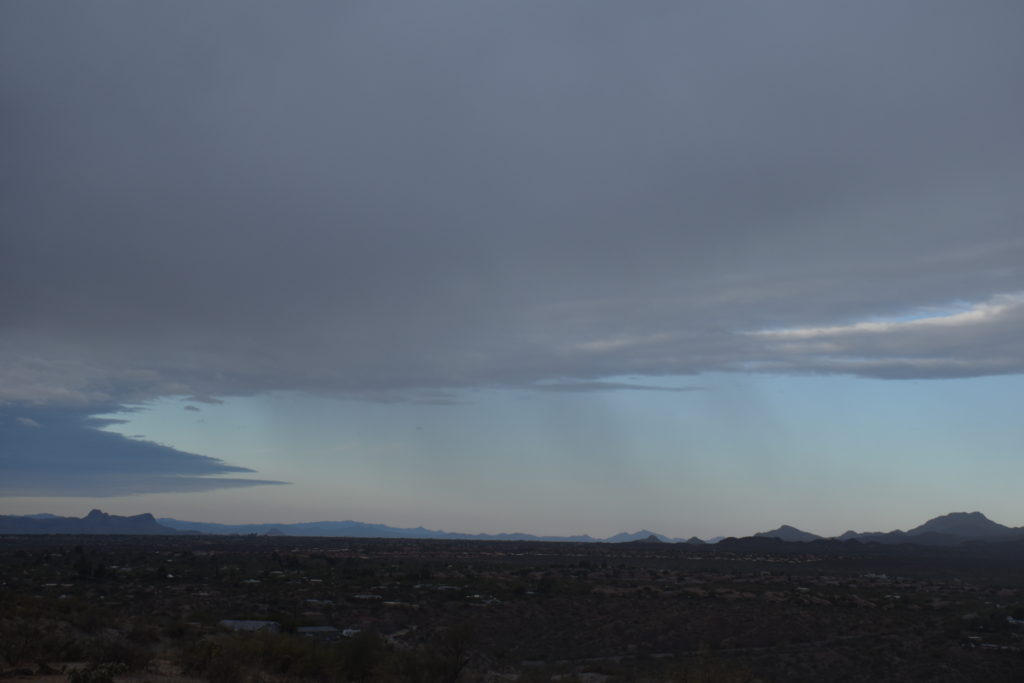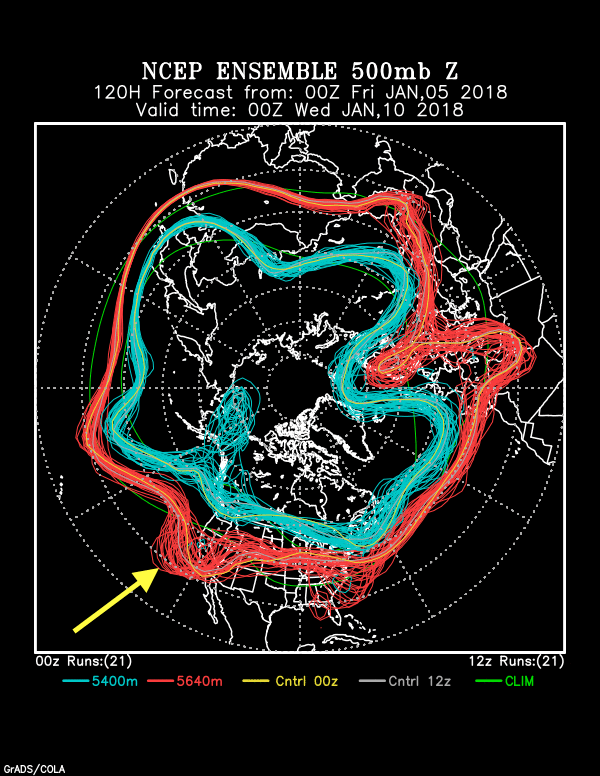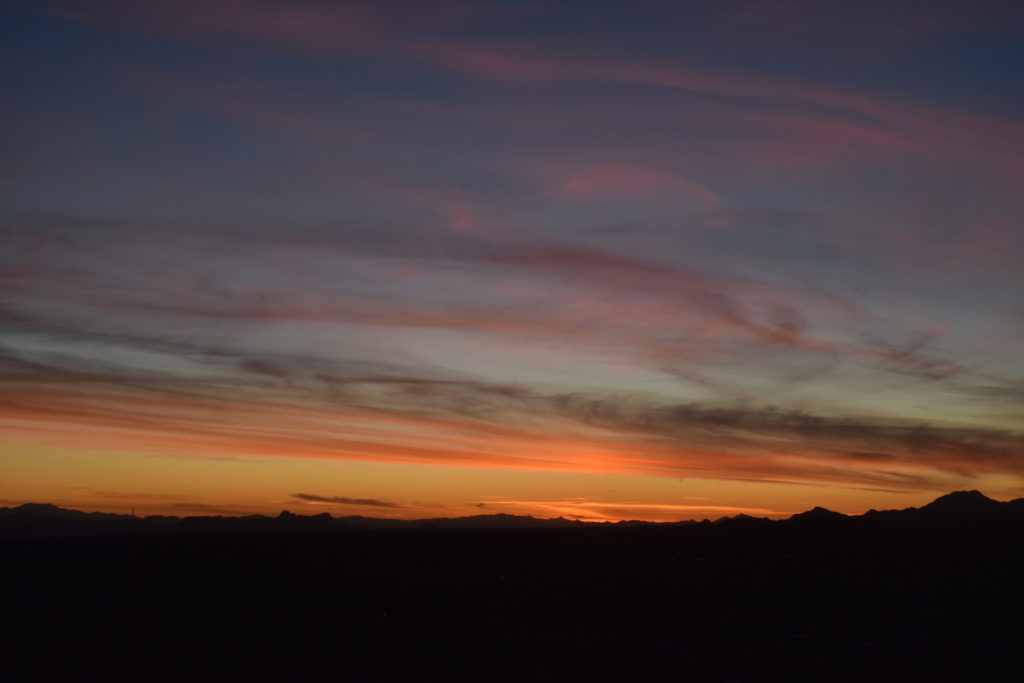
The End.
—————————————
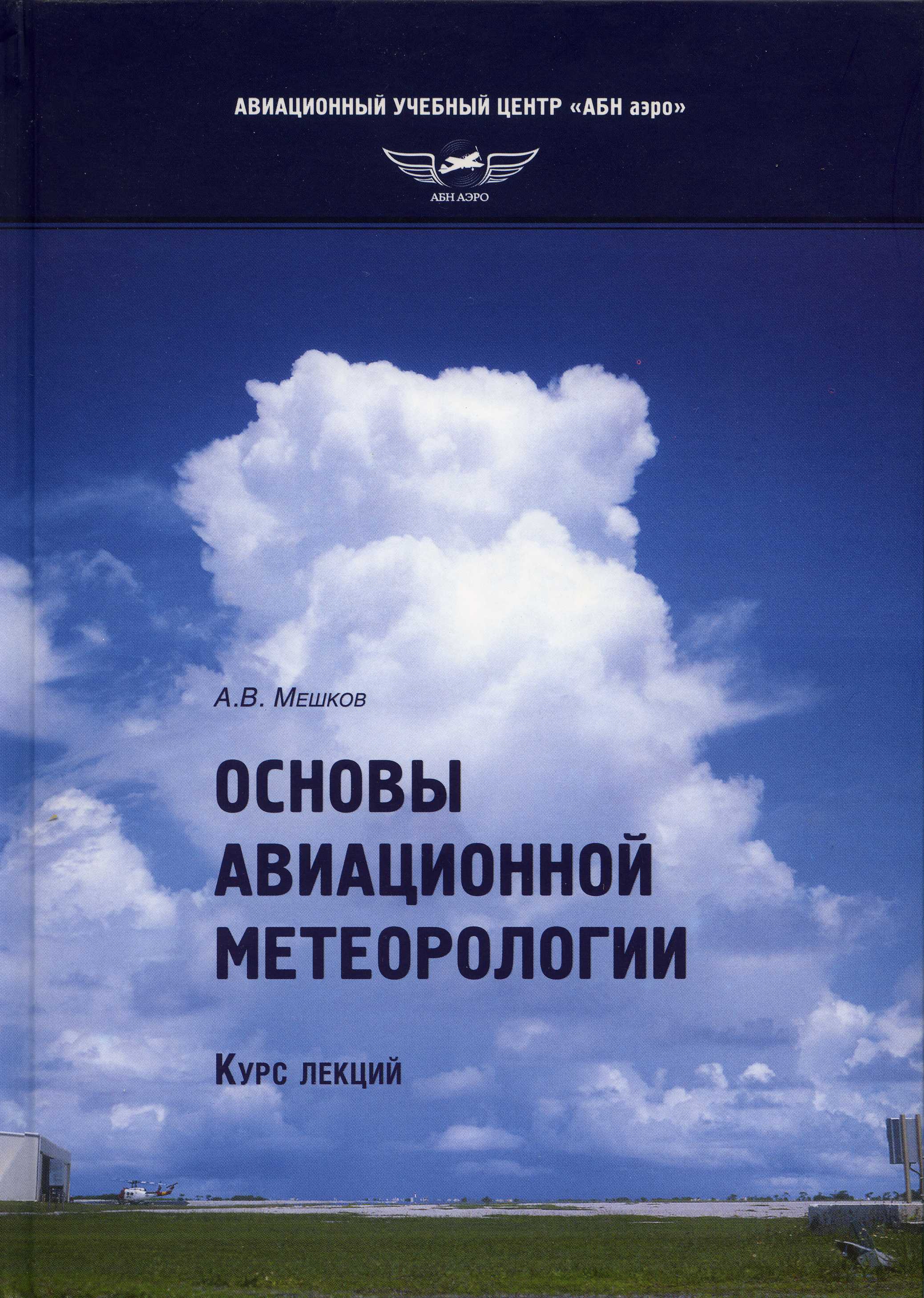
About real clouds, weather, cloud seeding and science autobio life stories by WMO consolation prize-winning meteorologist, Art Rangno

The End.
—————————————

0.22 inches was, indeed. how much rain fell in the form of drops from Nimbostratus clouds yesterday as a modest little rain band generated by a rapidly moving trough swept through during the afternoon. Regional precip values can be found here. Our local area got the most, up to about a quarter of an inch, as often happens in marginal storms.
Yesterday’s storm marked the beginning of the new, more normal weather regime for southern Arizona, as has been blabbed about here in recent weeks. No more week after week of droughty weather with temperature far above normal, the kind of weather that has marked this whole fall and winter so far! I. e., “Thank you very much, a snowbird might say, but get the hell out!”, the rest of us might conjure up, thinking about the needs of our desert’s wildlife and vegetation.
Indications are now that below normal temperatures and above normal precip are ahead for us and all of Arizona in late Jan and early February.
The evidence for these claims?
Below, the stunning, jaw-dropping evidence for this seemingly outlandish assertion in the form of an ensemble (spaghetti) plot generated by NOAA last night. I have followed these charts for almost ten years now, and I cannot remember when such a strong signal (clustering of flow lines) 15 days out has occurred before in our region.
So, excessively excited this morning when I saw it! Its been annotated with excitement text.
This troughy pattern begins to take place on January 30th. Until then, a strong but dry cold front with a lot of wind comes by in a few days, on the 25-26th.
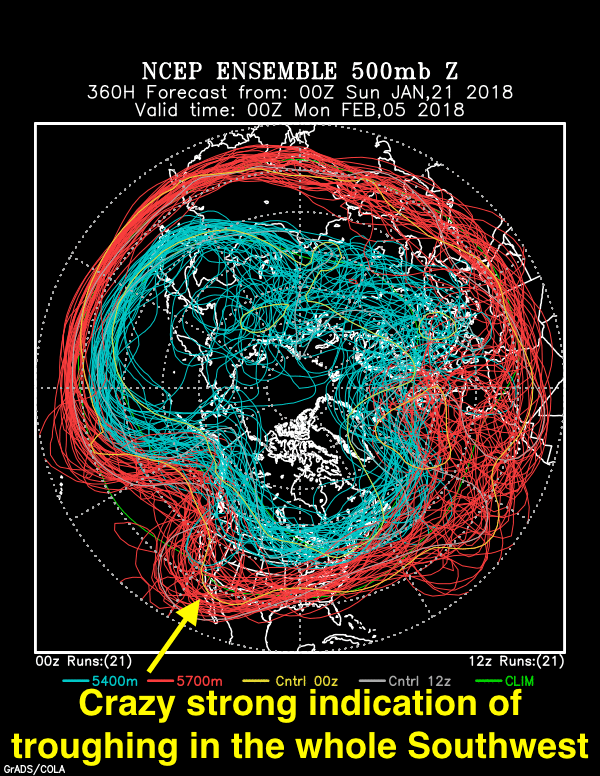
The whole interesting, if excessively gray story is shown below:
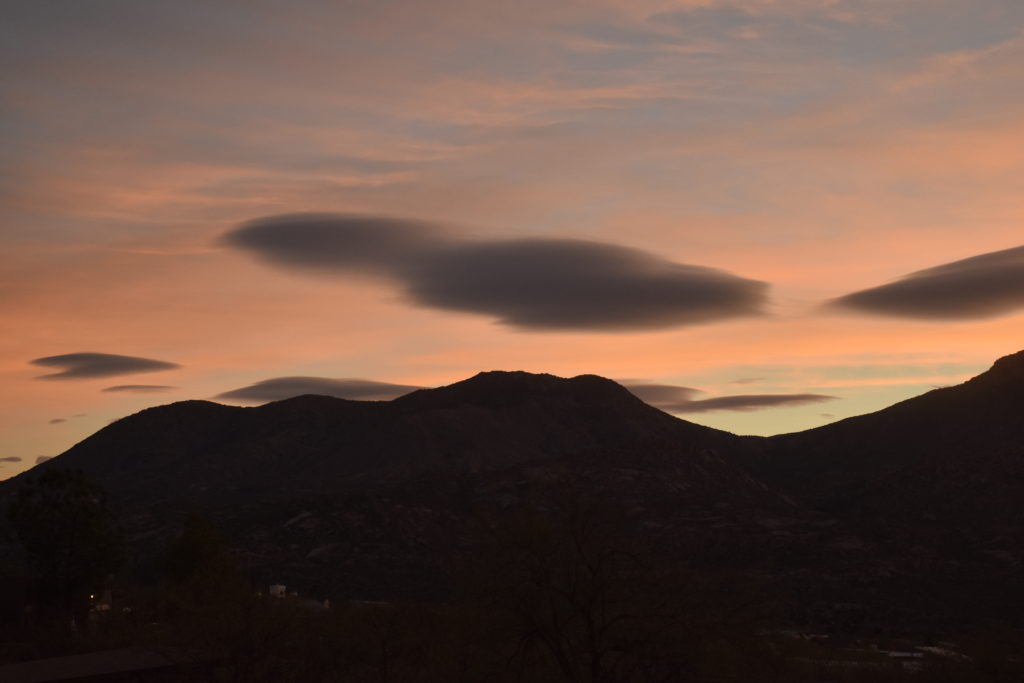
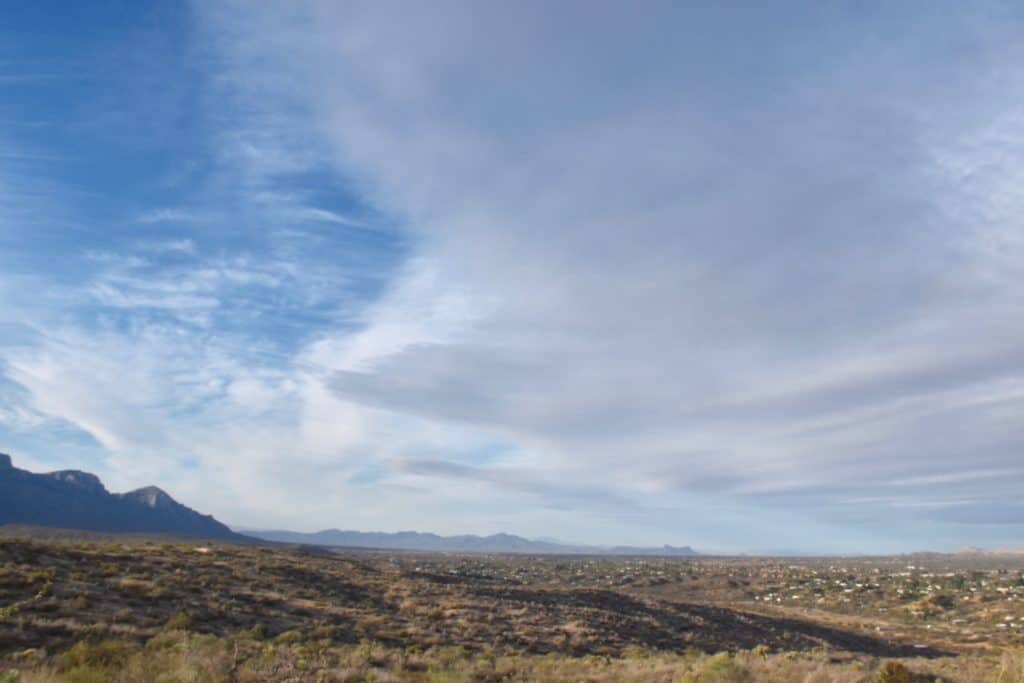
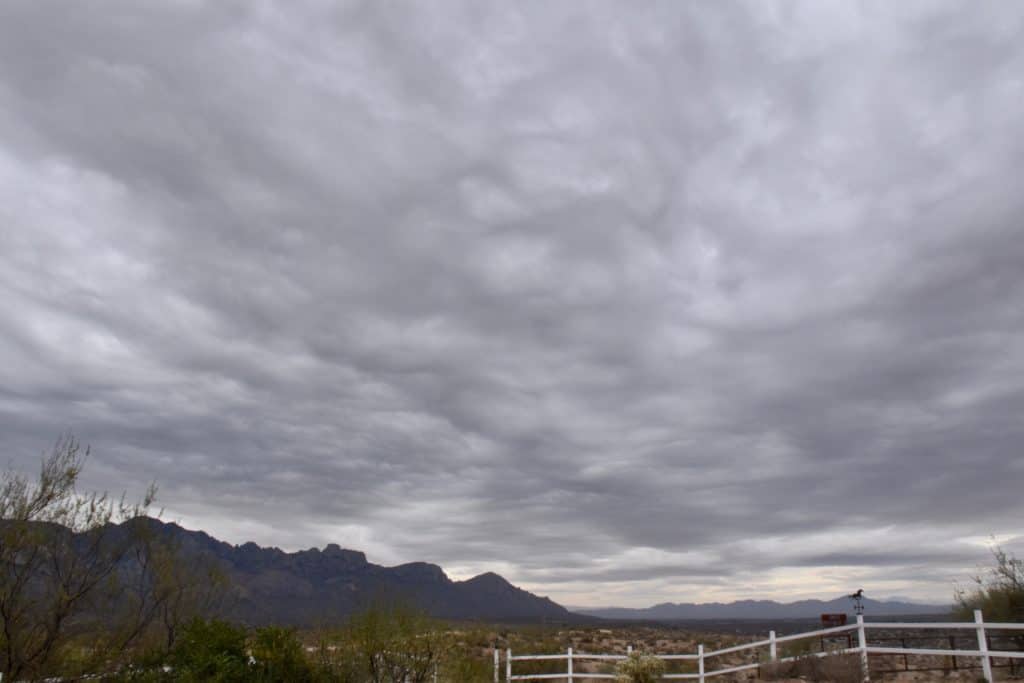
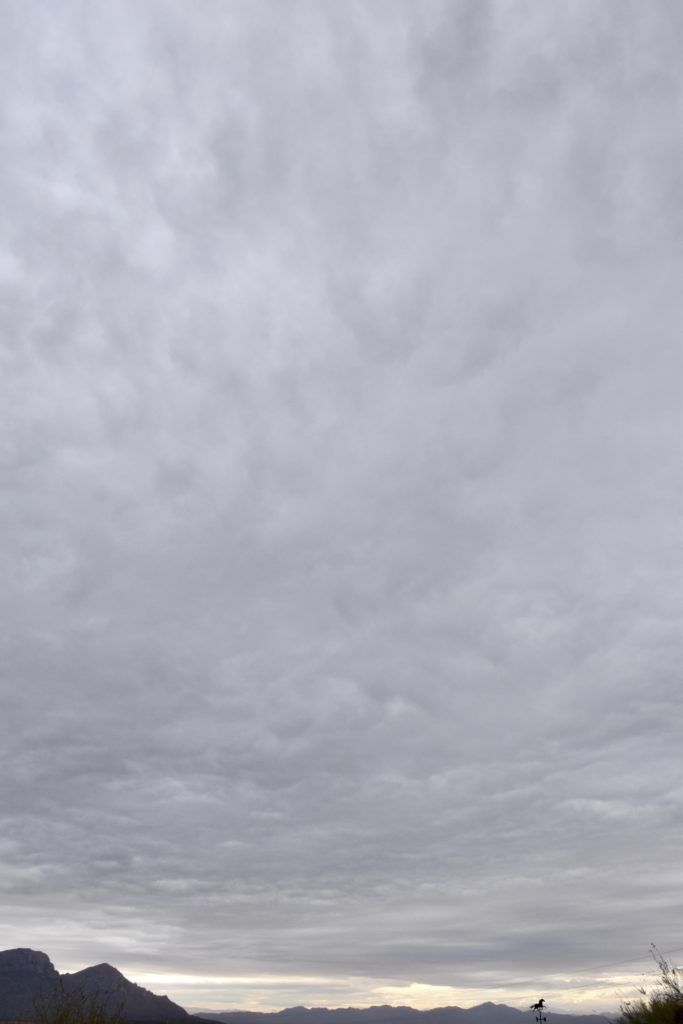
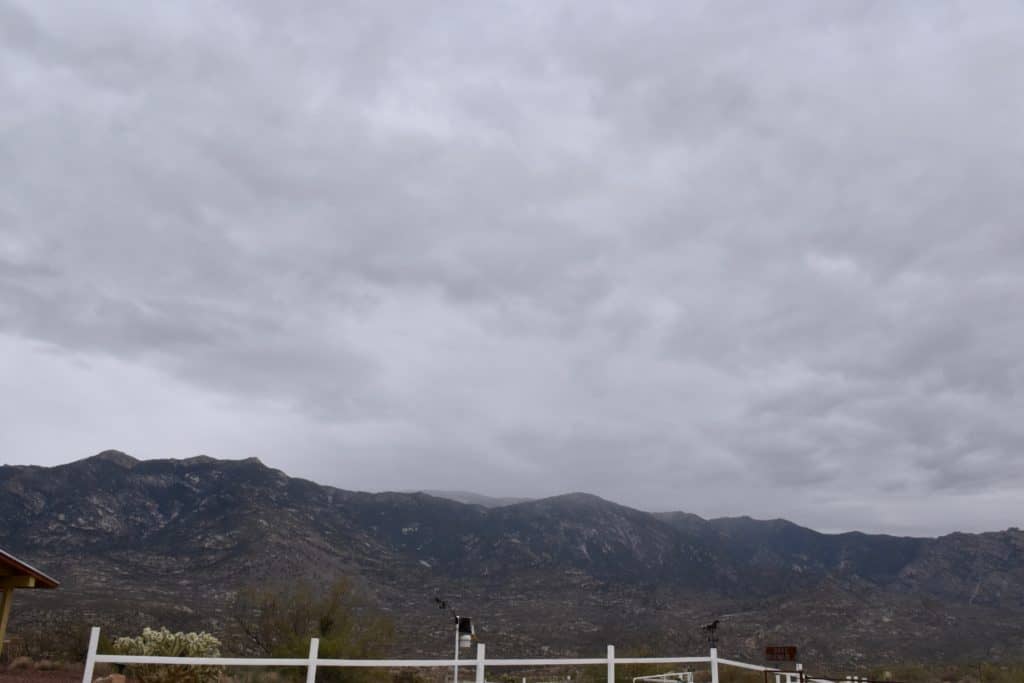
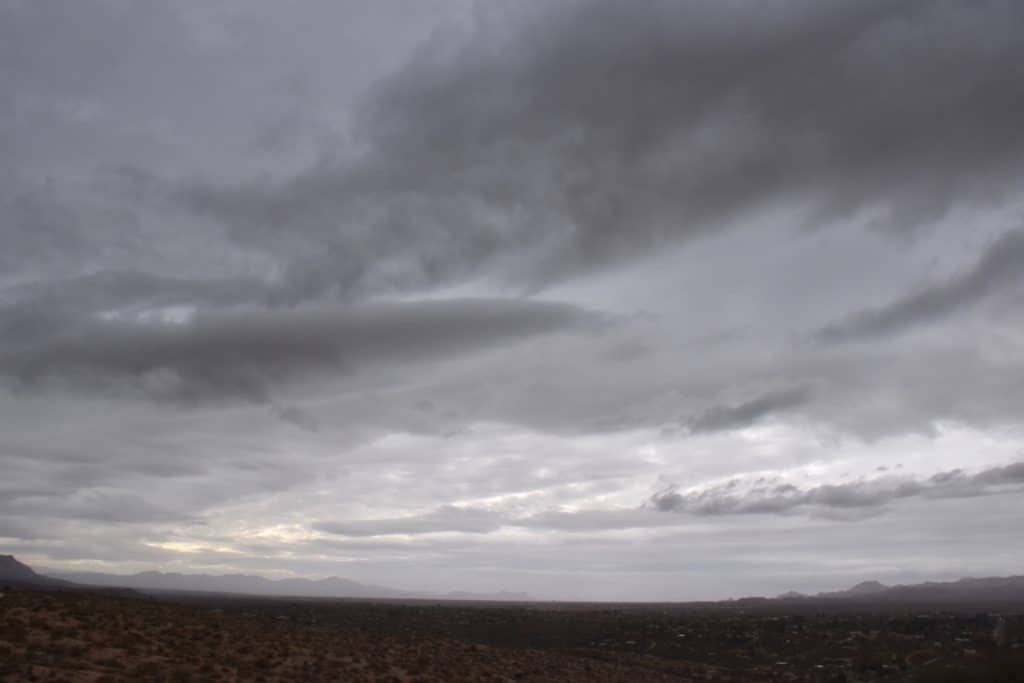
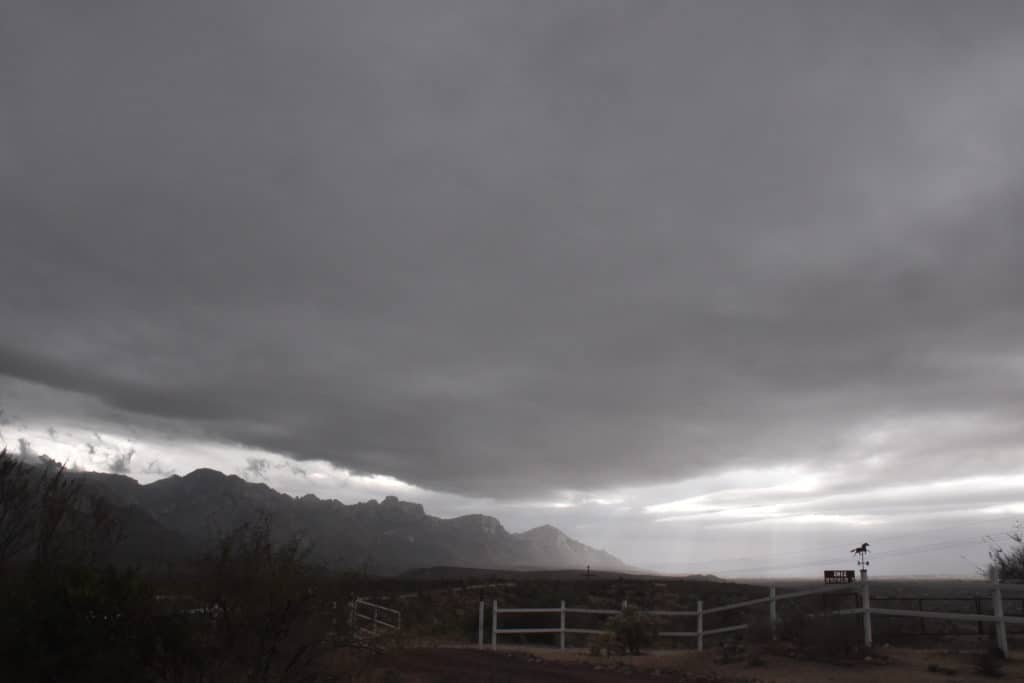
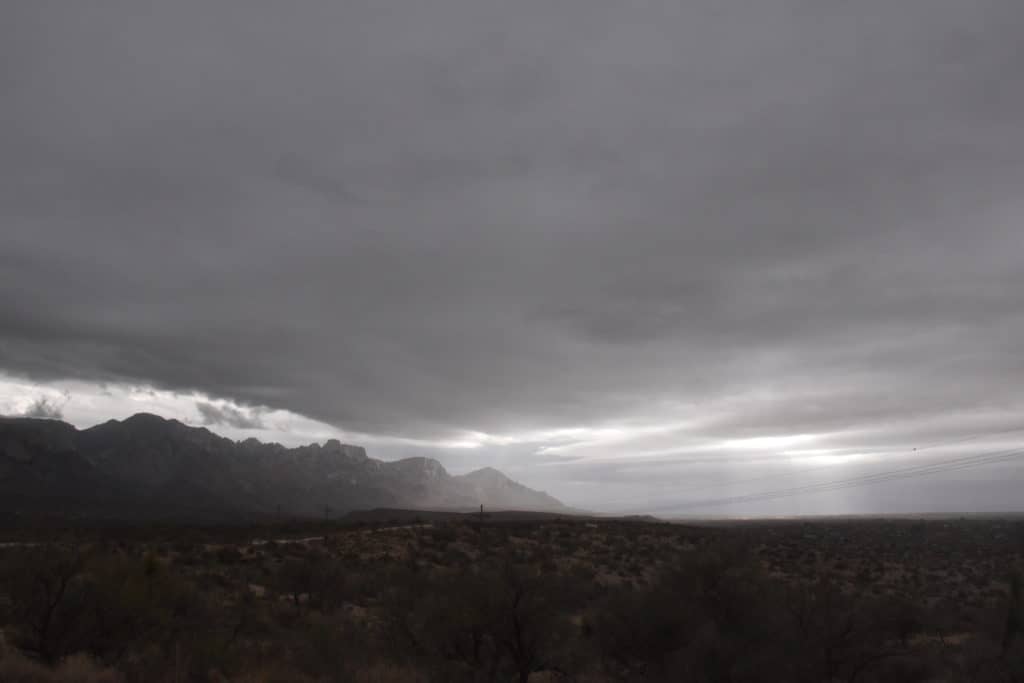
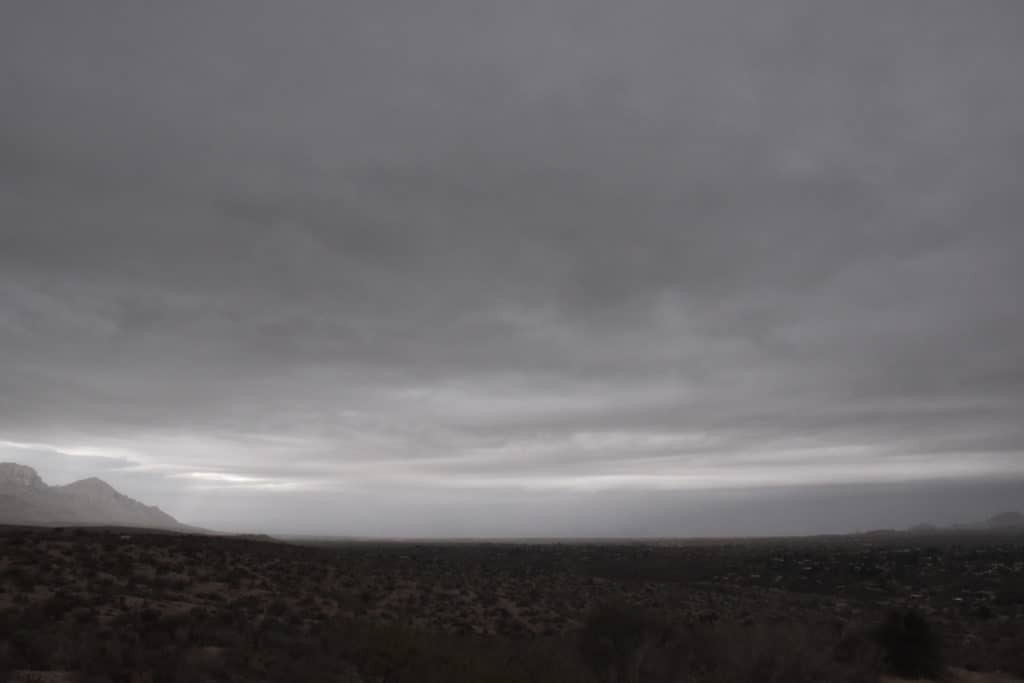
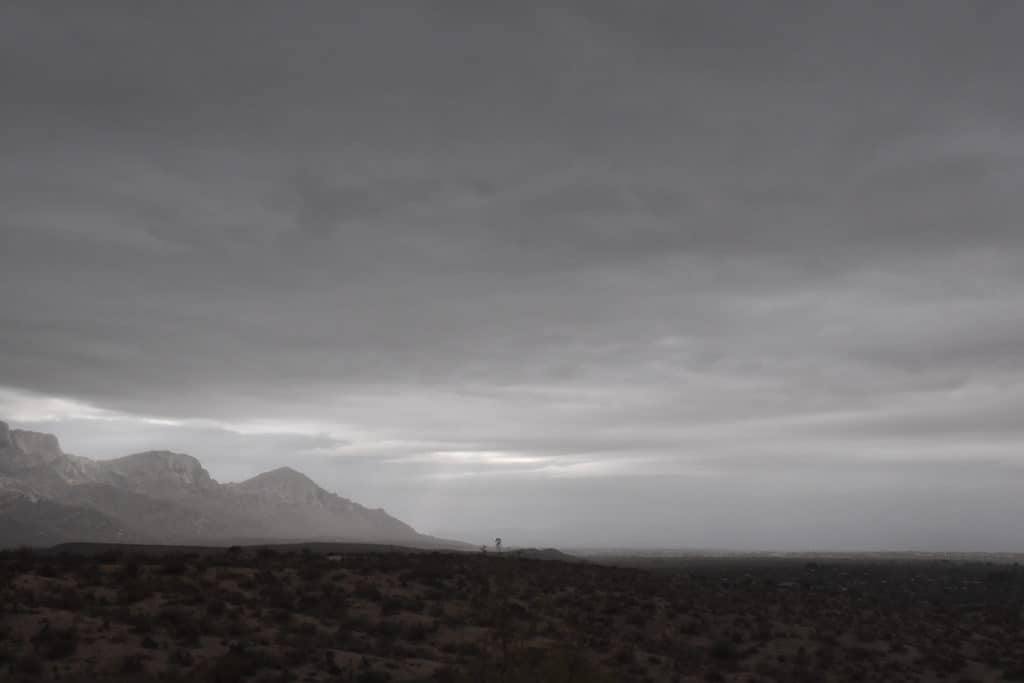

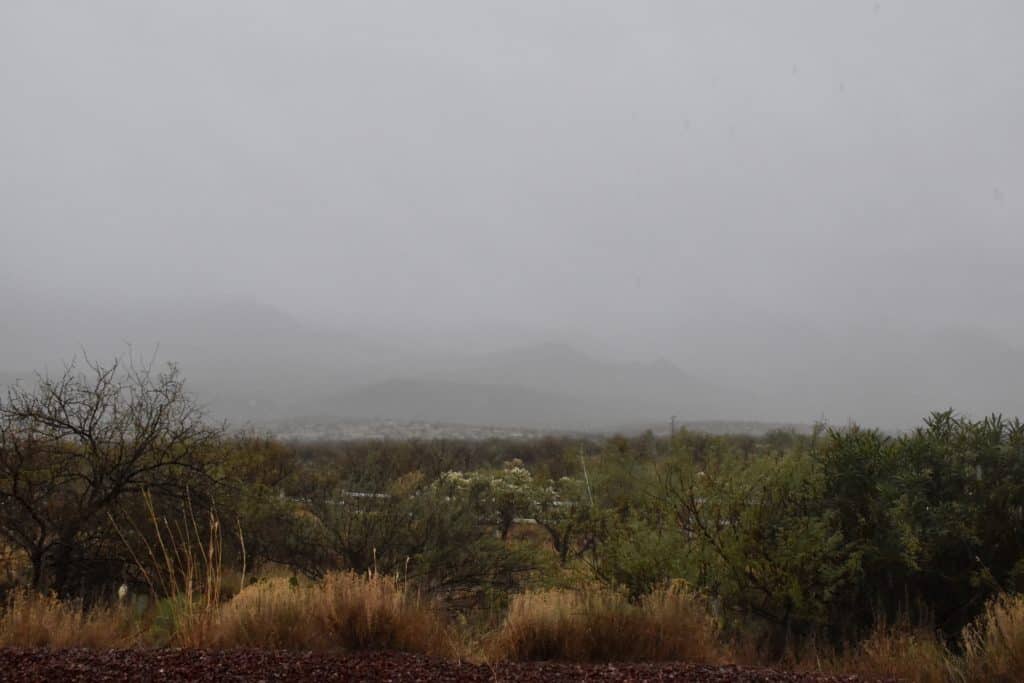
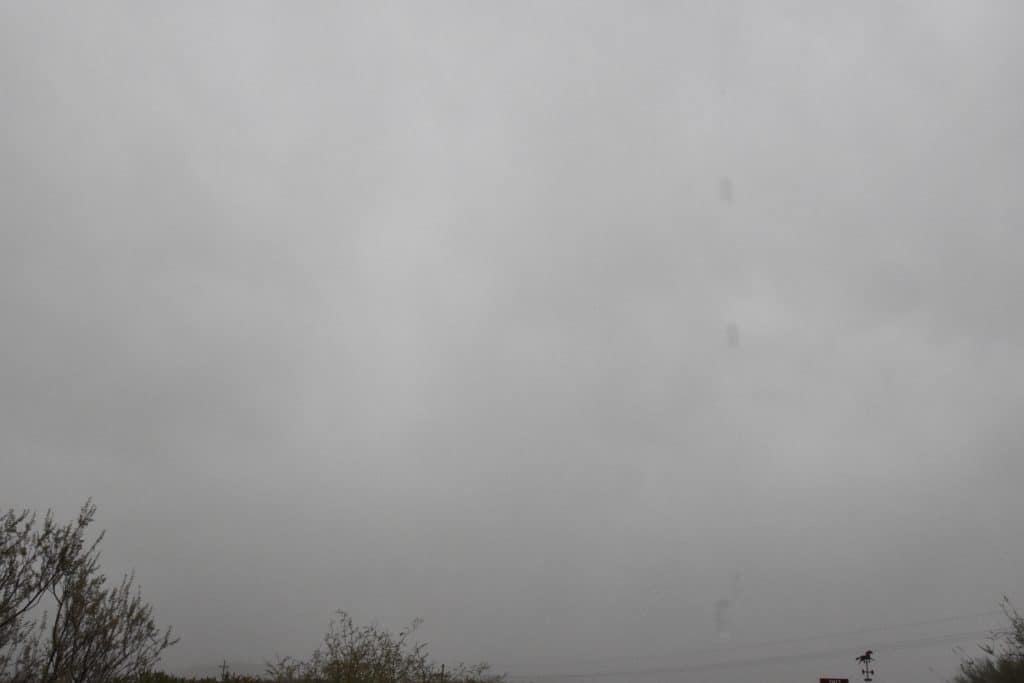
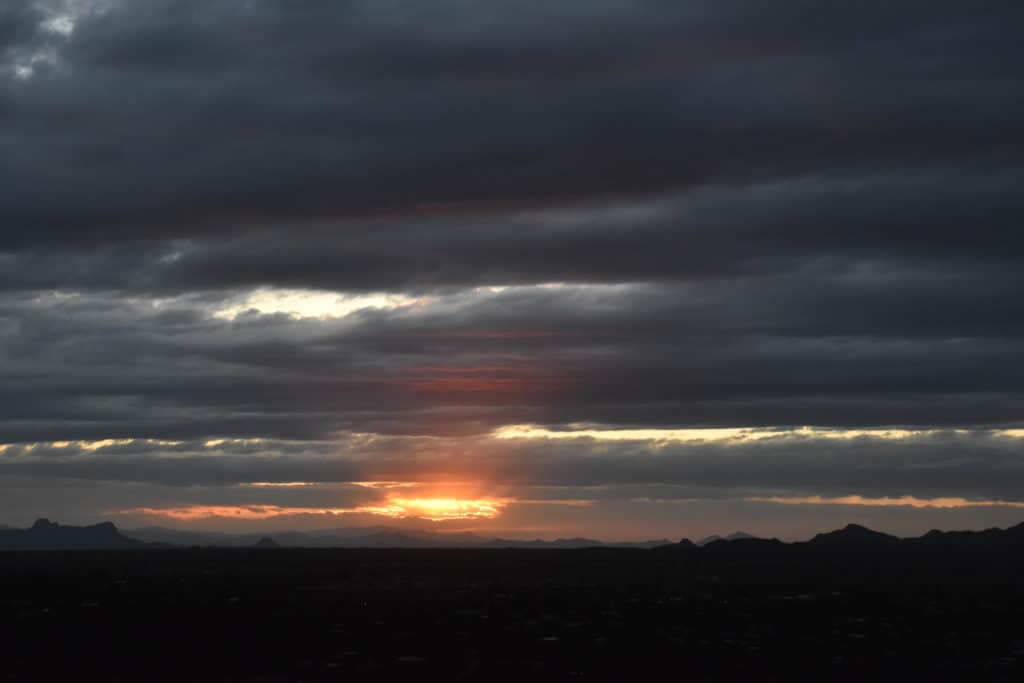
The title sums up where we are now. Will we go have more rain? Oh, yeah. But not right away, as you already know.
Keep cameras at the ready. Have some nice lenticulars in the lee of the Catalinas this morning if u look.
FROPA (weather text for “frontal passage” and cold air burst into Oro Valley and Catalina likely to be fronted by a lower arcus-like cloud that comes over the Torts later today. That should be dramatic, though personally I will complain about cold air right after it hits.
Still riding the forecast wave of 0.3 inches, though mods have varied from nothing to about that now. Yay!
Since its already windy, there’s a good chance of more windy (from the SW) right up until FROPA when the wind will turn to the NW for a while.
The End
“Rainy portent”; is there a better phrase for a desert than that? I don’t think so. See mini-discussion below, and below that, some soapboxing! Very excited today! Where are my pills?
Now, let us discuss the top 100 weather blogs:
Bob Maddox‘ superb site, representing Tucson, makes the list ! This note and info from pal and fellow weather fiend and fellow science investigator, Mark Albright1:
“Some notable blogs in the list, Mark notes:1) Watts Up With That2) Roy Spencer11) Cliff Mass Weather and Climate (U of Washington Huskies!)
28) Judith Curry, Climate Etc (once worked at U of Washington Huskies as a visiting grad student
30) RealClimate (from the Huskies)
33) Wasatch Weather Weenies, Jim Steenburgh (graduated from from the U of Washington Huskies!)
65) Mike Smith70) Madweather – Bob Maddox (Tucson AZ) (Was grad student of mighty prof and neighbor, Bill Cotton, whose heard of the Huskies!
83) West Coast Weather – Michael Fagin”Not sure if “we” (to distribute poor performance beyond a single author) even made the top 1000; the list doesn’t go that low (or high).But, we’re not really a weather site, per se, to put a positive spin on a glum finding. We talk mostly clouds here. not so much weather. Contains sophomoric, droll, and tongue in cheek “humor”, too. Maybe Cloud Maven Person’s blogulations would make the top 1000 CLOUD sites!The weather ahead and beyond ahead
Cool with passing rains every coupla to few days, maybe some snow with one of those events, as they continue into February. The first storm begins on January 20th, and then its one threat after another. This new “troughy” regime should bring the January rainfall total in Catalinaland over average of 1.60 inches (1978-2017). Currently, we’ve logged 1.10 inches in a NWS style 8-inch diameter gauge.
Looking for tiny green sprouts out of our desert soil now.
The End
(except for all the footnoted sci commentary below)
sci commentary and soapbox module——
1Mark Albright routinely calls attention to suspect temperature data that’s out there, and other questionable aspects of some climate statements2. He is widely well thought of for these conscientious efforts in bringing temperature errors to people’s attention3. Mark was former State Climatologist of Washington State, to be redundant, for many years. Was more or less fired for questioning claims of HUGE snowpack losses in the Pac NW between the late 1940s/50s (a cold era that started after a warm era in the 30s and 40s) and the late 1990s (a Niño-filled warm decade); to wit, it was a cherry-picked study, as we learned later via Stoelinga et al 2010 pdf, and by the mountainous snows that occurred immediately after that bogus claim was published in the Bull. Amer. Meteor. Soc.
Could snowpack go down gradually over the years in the Pac NW due to warming? Sure! But there was no need to cherry-pick data to create the appearance of an imminent calamity! It destroys credibility when objective investigators like Stoelinga, Mass, and Albright check into them. Michael Mann, of Penn State and “hockey stick” fame, also fueled the fires of skepticism and doubt needlessly by refusing to give the details (data and methodology) on how he created “The Stick” which eliminated such climate anomalies as the Medieval Warm Period and the Little Ice Age that followed. If you read Science magazine, they often refer to the MWP and LIA! What’s Up With That? It can’t be both,; didn’t happen but did happen????!!!!! Dammital.
“Fellow investigator”, CMP? Oh, yeah, baby! Your CMP likes questioning exaggerated cloud seeding reports after they’ve been published in peer-reviewed journals! Or checking into suspect cloud reports *(after all, he is the “Cloud Maven”) that are the foundations of seeding results. He’s even gone to foreign countries (well, one) to check out suspect cloud reports, help the people of that country understand their clouds.
While CMP has a number of peer-reviewed pubs that are critical of cloud seeding (nearly all co-authored with the late mighty Prof. Peter V. Hobbs), maybe today, as do so many good scientists and others, those critiques would just be in blogs? I dunno.
Journal editors have tremendous power over your getting in these days via who they give your manuscript to to review. (Well, that’s always been the case).
But today that power has grown enormously since they (a single editor or an editorial board) can refuse your manuscript on first sight (its “D. O. A.)” and not even send it out for peer-review! This is an intolerable situation since non-objective factors will certainly creep in to such a process. As an example of unwanted but valid science, Stoelinga et al took years to get into the J. of Climate.
Note to journal editors: Send the damn thing out! Let legitimate, even adversarial reviewers, determine the fate of a manuscript, with the stipulation that the author (s) have a chance to rebut adversarial reviews which will likely reject a manuscript prima facie. They’re the best ones!
And, no “pal reviews”! They’ve cost us so much in the early published cloud seeding claims here, and in Israel , believed to be accurate by our best scientists and national panels, but cost us and Israel tens of millions of dollars of worthless cloud seeding based on those ersatz published results.
2Some professors and students at the U of WA delete Mark’s e-mails on arrival; they prefer not to hear about discrepancies or other weather data that might cast doubt on today’s climate issues. As far as I know, only Prof. Cliff Mass has, from time to time, openly supported Mark’s findings putting him even more in the cross hairs of some of his fellow faculty members and especially some other climate scientists and students/post docs since he has often scrutinized and found wanting some gross claims on climate change. We are in a science era where questioning even the magnitude of the warming ahead, even if we believe its coming, is seen as untoward. Science is not as it should be!
3If you believe that, I also have some ocean front property in Nebraska I’d like to sell you.
Check it out, spaghetti1 lovers:
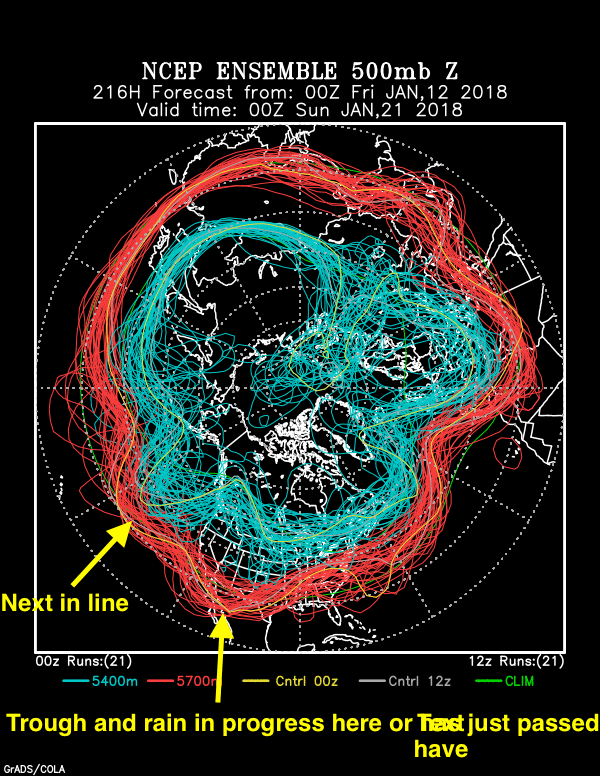
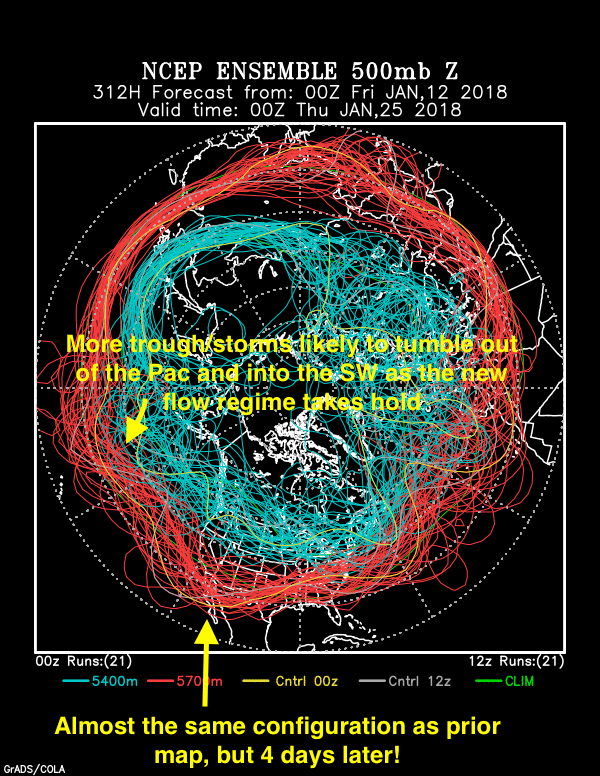
So, enjoy the warm, dry spell we’re in now, if that’s what you like and that is why you are in old AZZY, since you probably won’t be as happy after the 20th or so.
Pretty excited about this change coming up, one that will break five months of below average rainfall here in Catland with January’s total likely to be above average now! Yay for desert greening, too, that soul-filling spring phenomenon we all need as much of as possible.
The End
—————————-
1You can go here and see the whole sequence from the NOAA spaghetti factory (aka, ensemble factory).
That was about three times more than CMP (me) expected, and it was such a fabulous a rain! That soaking amount should start the spring greening that we love here. With more rains in the pipeline, eventually, after another longish dry spell, maybe the spring bloom won’t be as bad as it once looked.
As we who love the Sonoran Desert know, its a pretty special place when it comes to rain. But only recently did I learn that the SD is the ONLY desert in the world (!!!) with TWO rain seasons, so great for a cloud-loving meteorologist1, though three or four rain seasons would be that much better. Now, after some interesting information, clouds: yesterday’s, of course: a study in gray2, more or less.
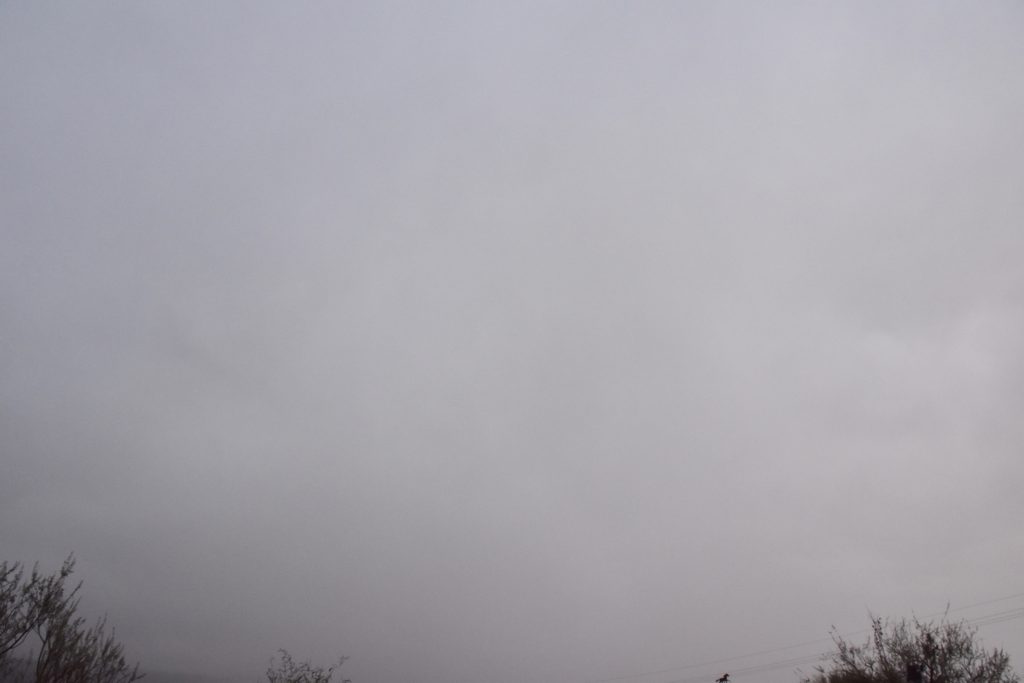
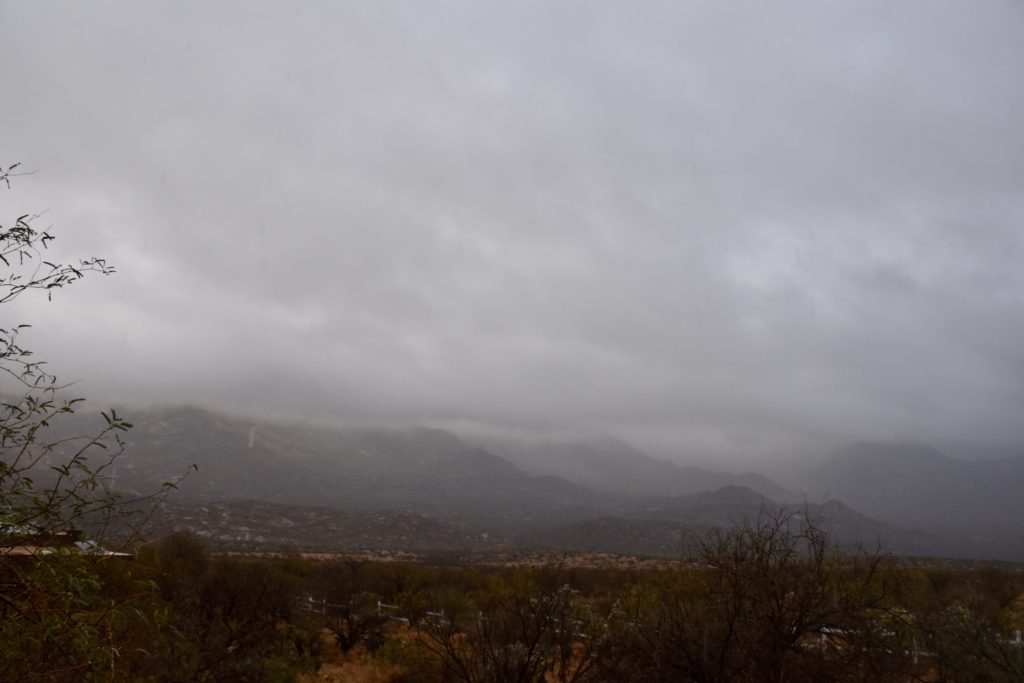
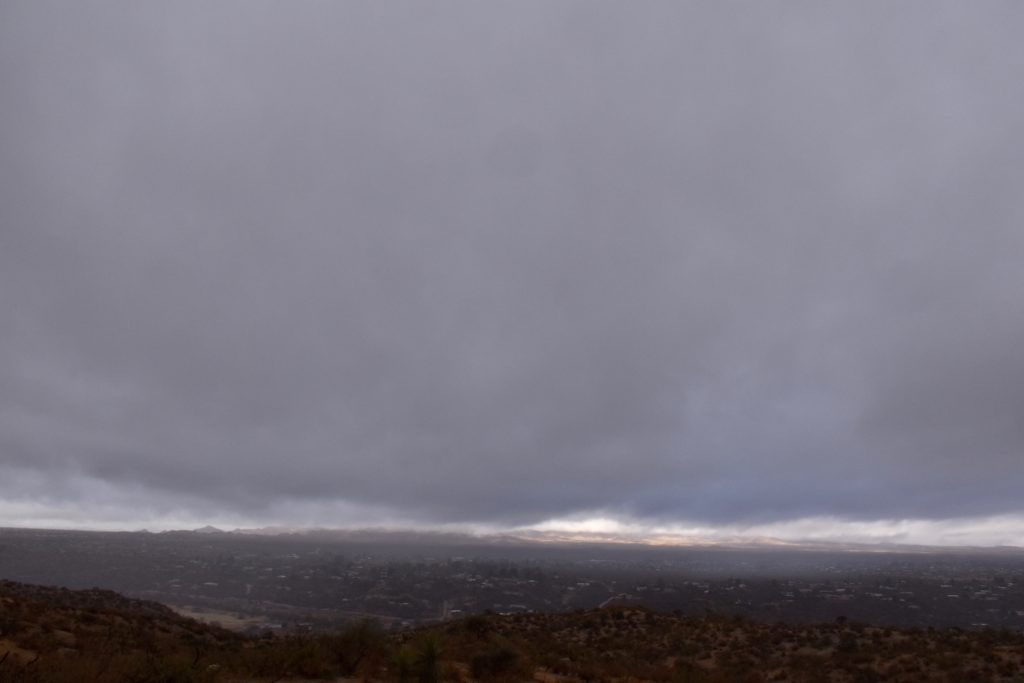
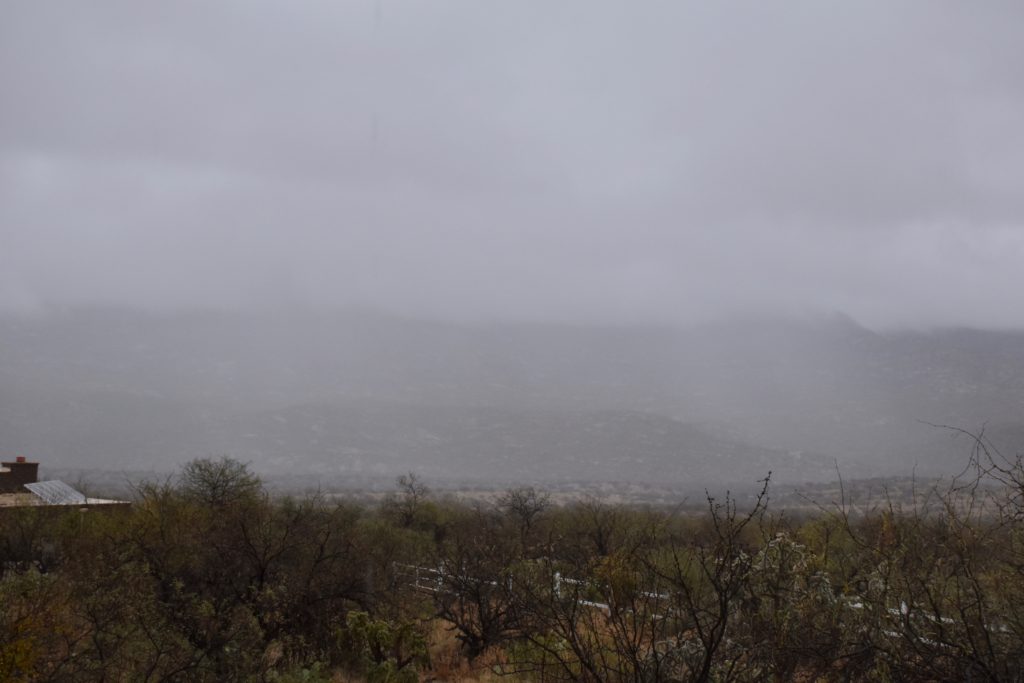
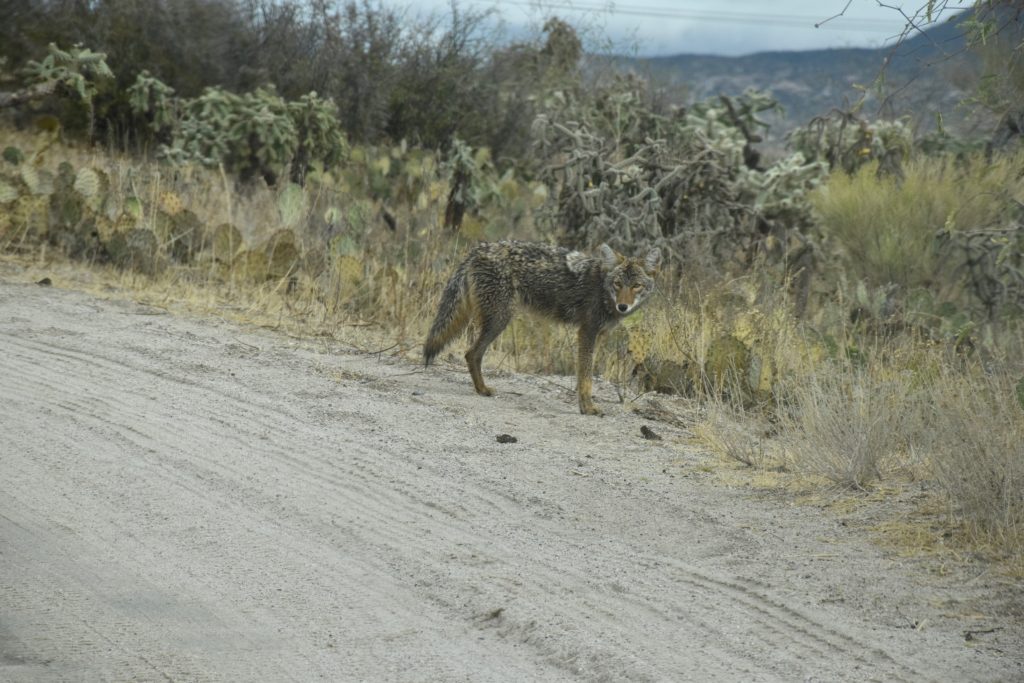
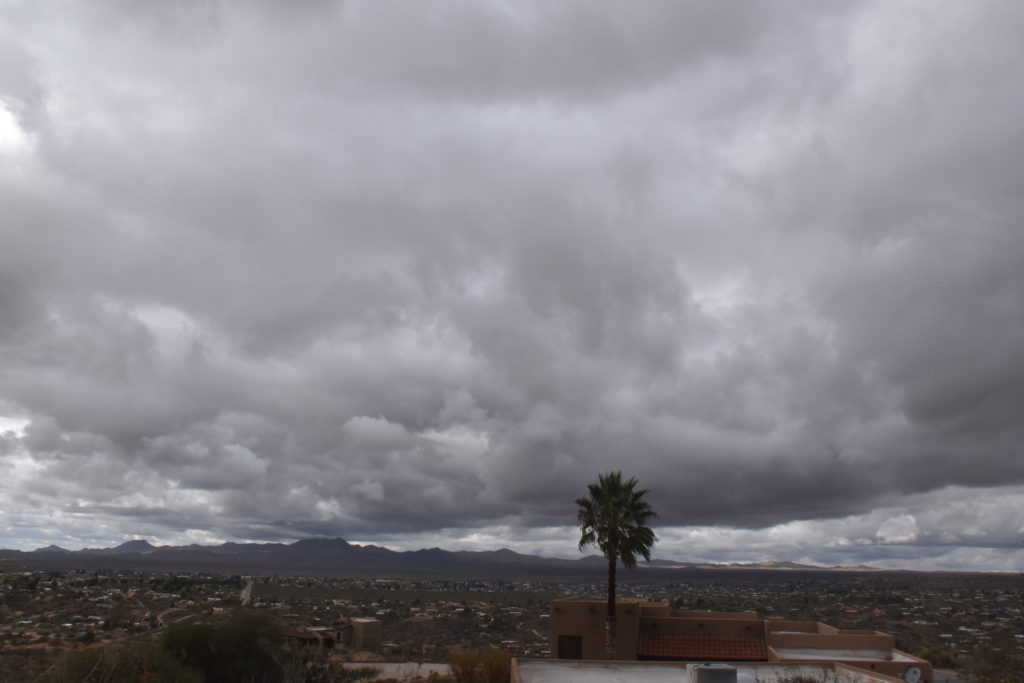
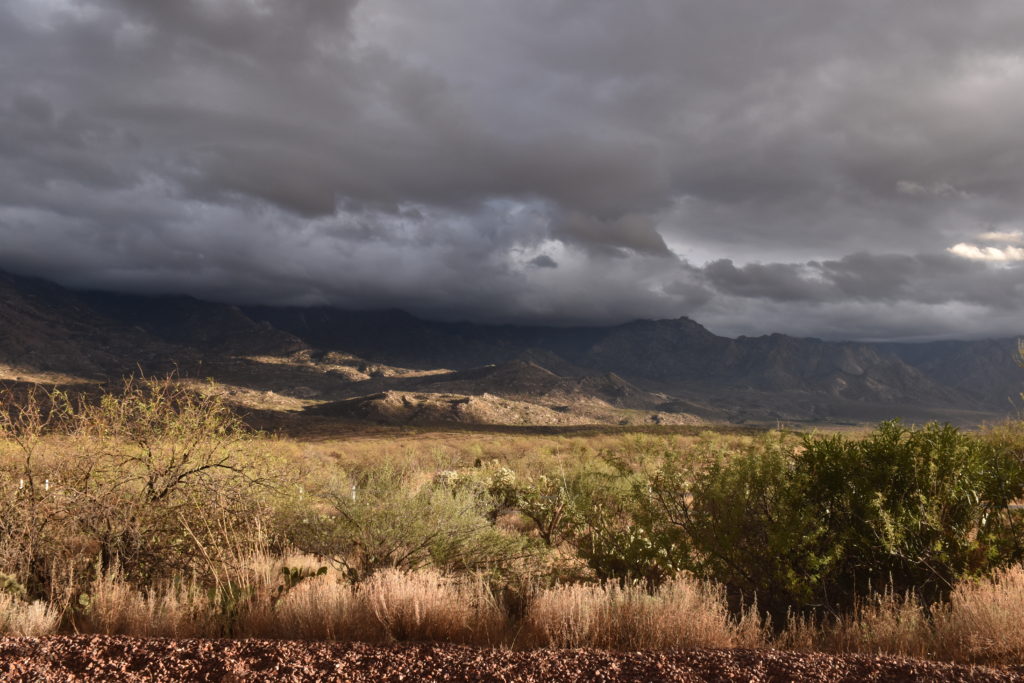
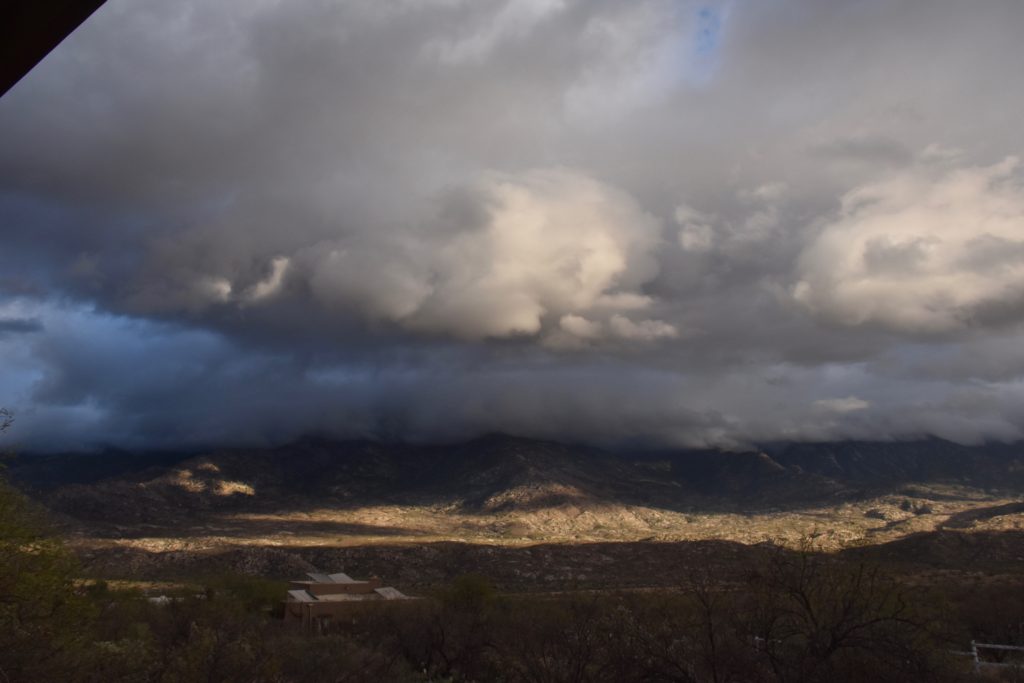
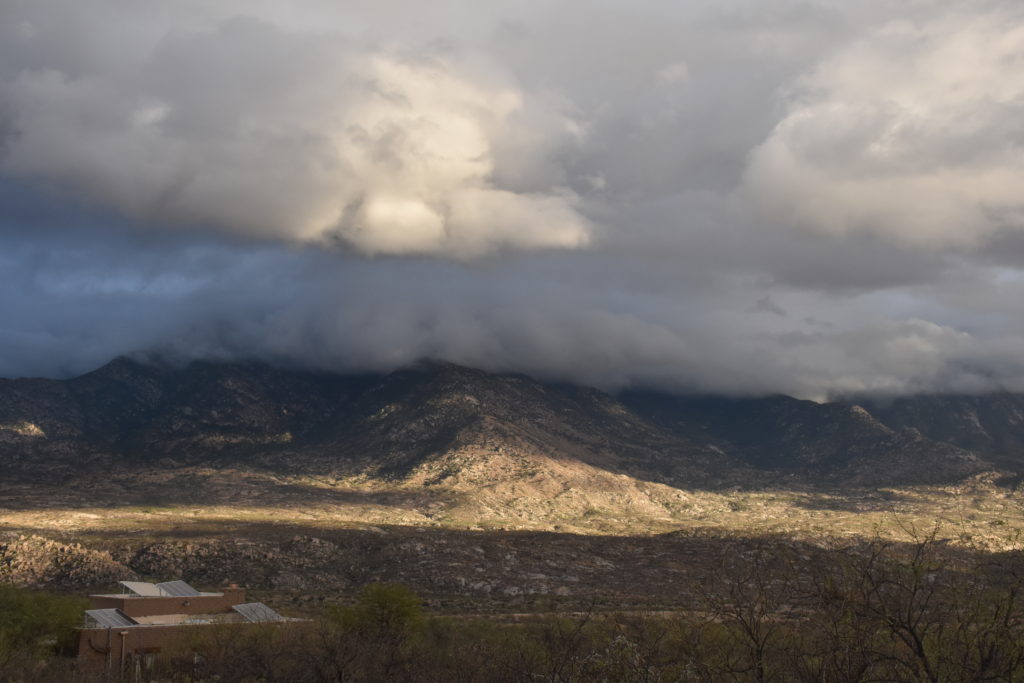
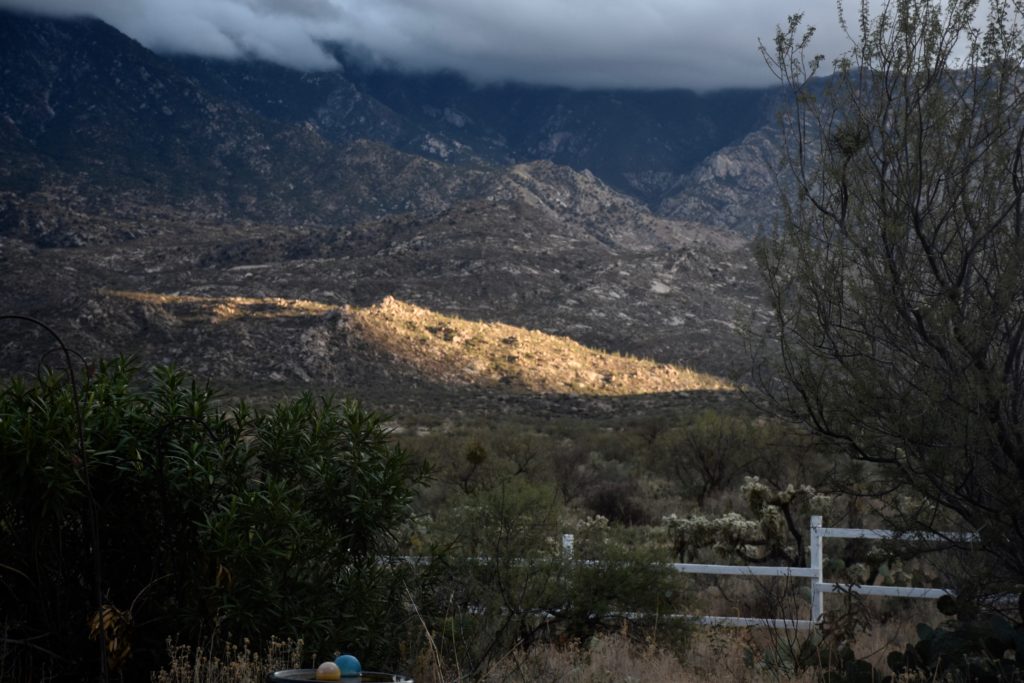
And then the great sunset of underlit Stratocumulus clouds…
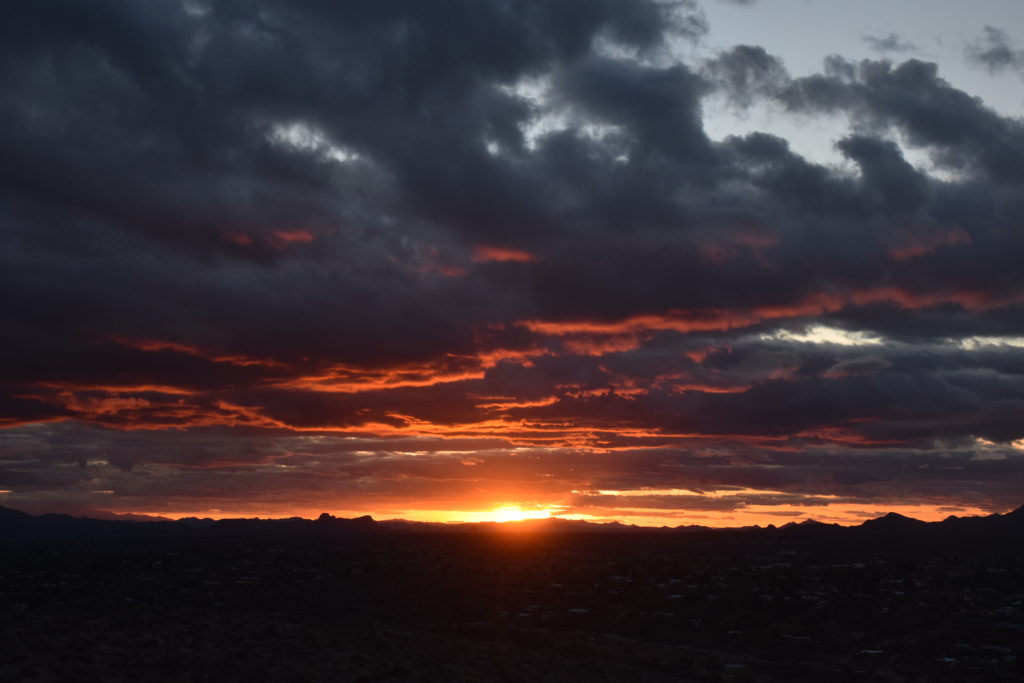
Notice that in the afternoon shots, no virga or ice was seen in any cloud! What up with that? Well, of course, if you’ve been coming to this site, you will know its because the cloud tops have descended to something above -10° (14°F) or so where ice begins to form naturally in these parts on most days. (There are exceptions, such as when drizzle or rain drops form in clouds; then ice can form almost spontaneously and readily at temperatures higher than -10°C, and that may have happened as yesterday’s storm ended.)
But, in a further educational (?) diversion, here’s the TUS sounding launched from the U of AZ around 3:30 PM yesterday (goes up at about 1000 feet a minute, btw).
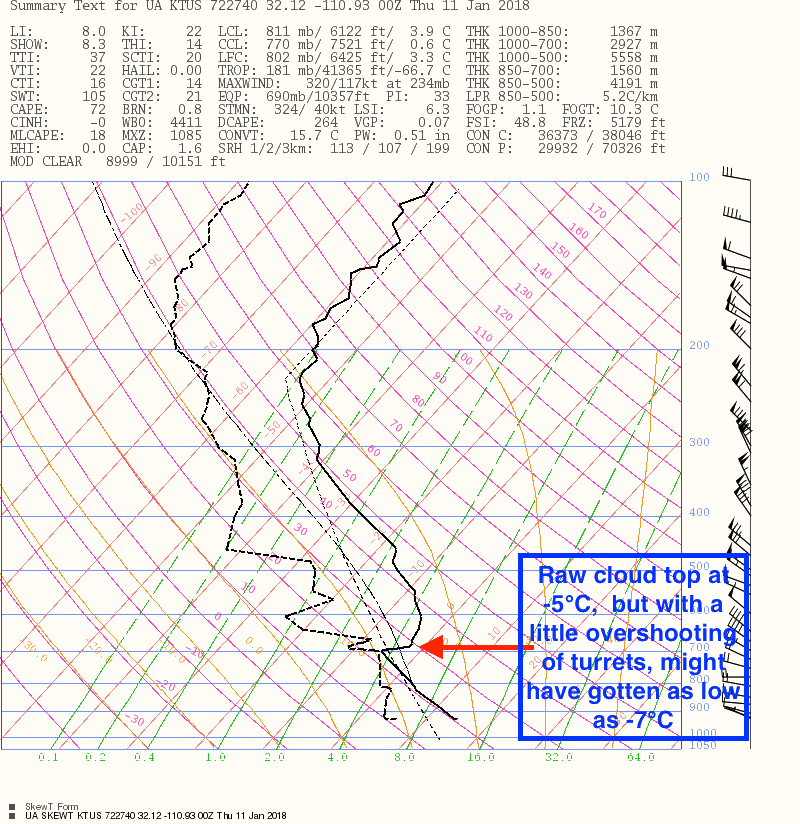
Still looks like a regime change is in the works after our dry spell, one that ends around the 20th. At that time it still appears that winter will take on a more normal aspect; a few dry days followed by rain/snow threats, that is, not weeks of dry spells!
2One of the interesting things about me is that my favorite color has always been gray; even in grammar school when I crayola-ed gray skies instead of a blue one with the sun stuck on it somewhere like the other kids did.
What an amazing and “productive” little rainband that was just after midnight! And more rain is likely with weaker bands just upwind here at 4 AM. Could we really approach an inch? Amazing. Didn’t seem possible in this small mind that we could amass that much. For a full regional rain table, go here to the ALERT gauge records.
An even more dense collection of rain totals can be found on the Weather Underground map for the Catalina/Tucson area *click on the precip button when you get there, radar, too). We seem to have done better than just about anywhere else in the state, with 2.94 inches at Biosphere 2 leading the way (thanks to those “TSTMS” and the rain gushes with them, I am sure.)
Now, after this ends, a long dry spell has to be endured, at least until around the 20th of Jan, at which time we hope the troughs and rain threats at least, will begin to barge in every few days, namely, and pattern more typical of winter sets in.
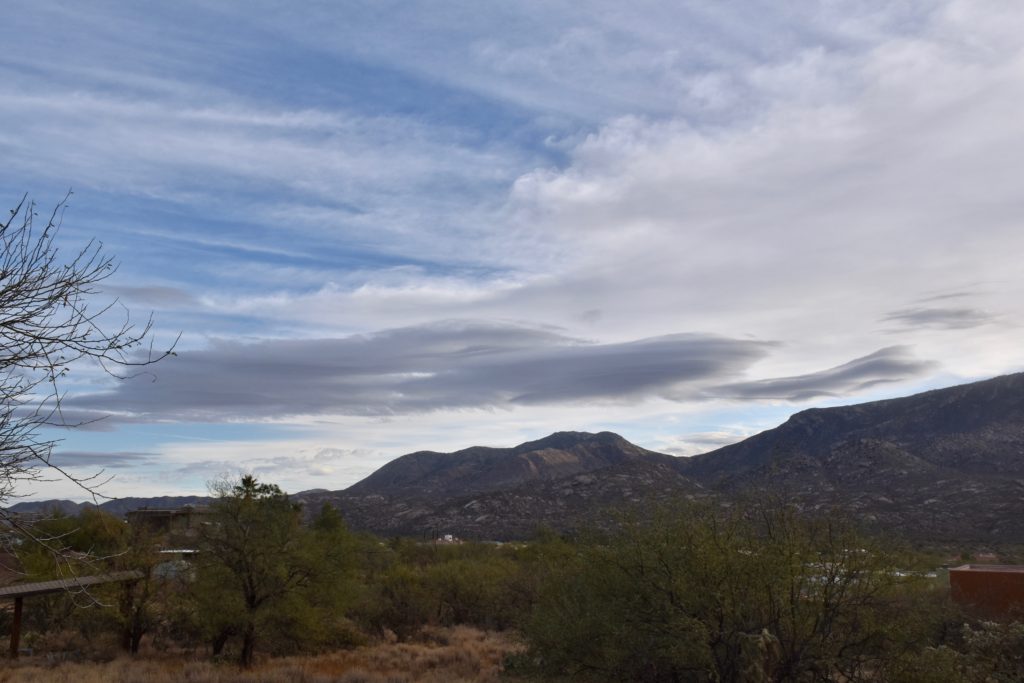
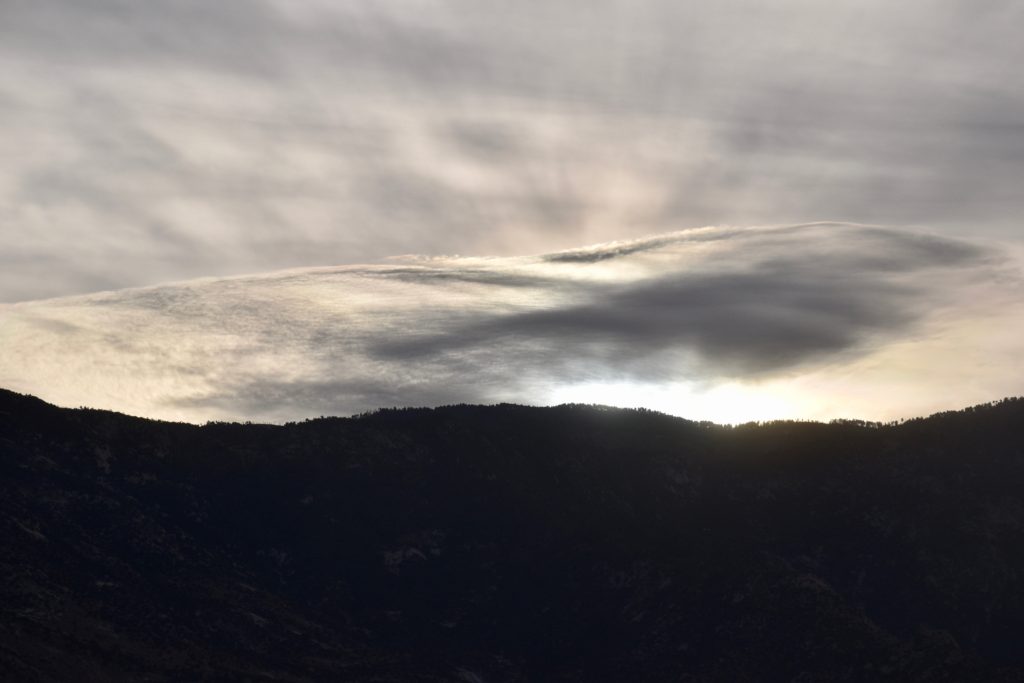
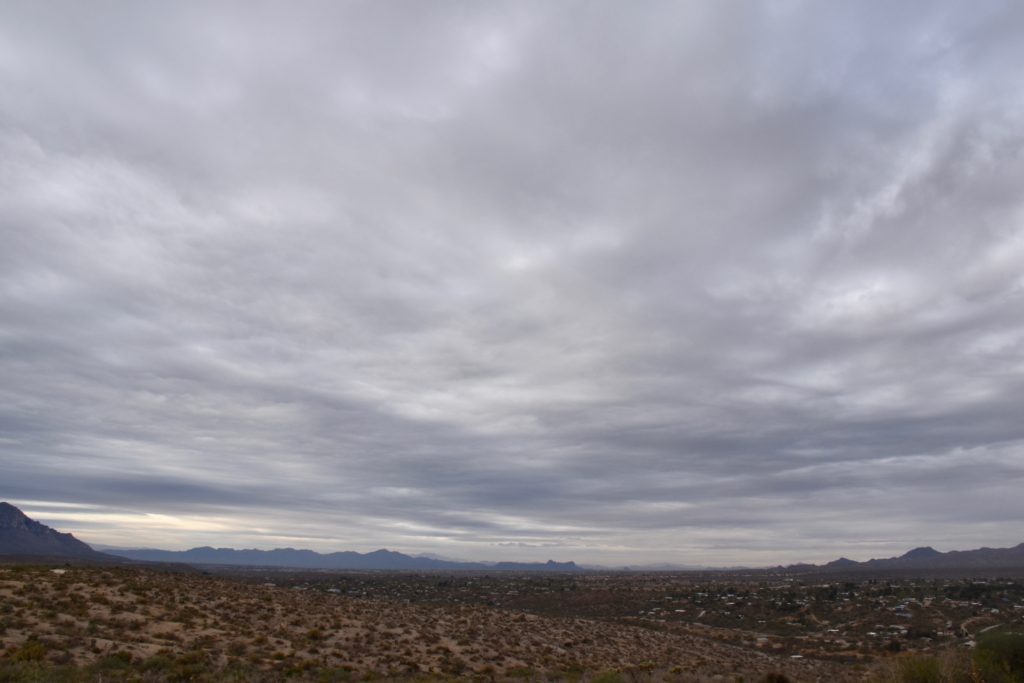
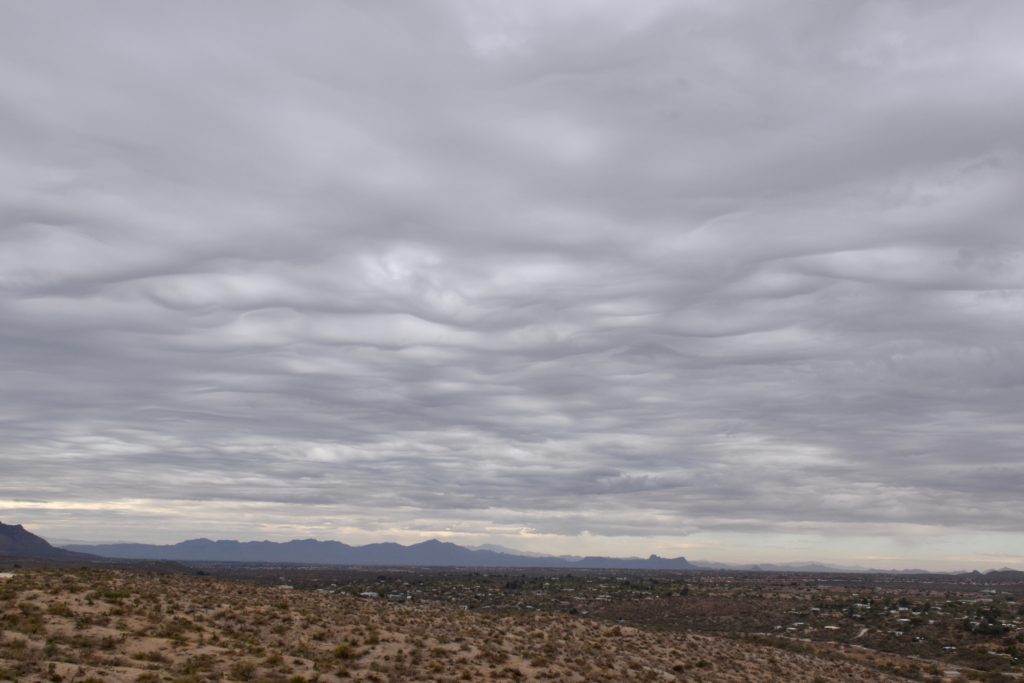
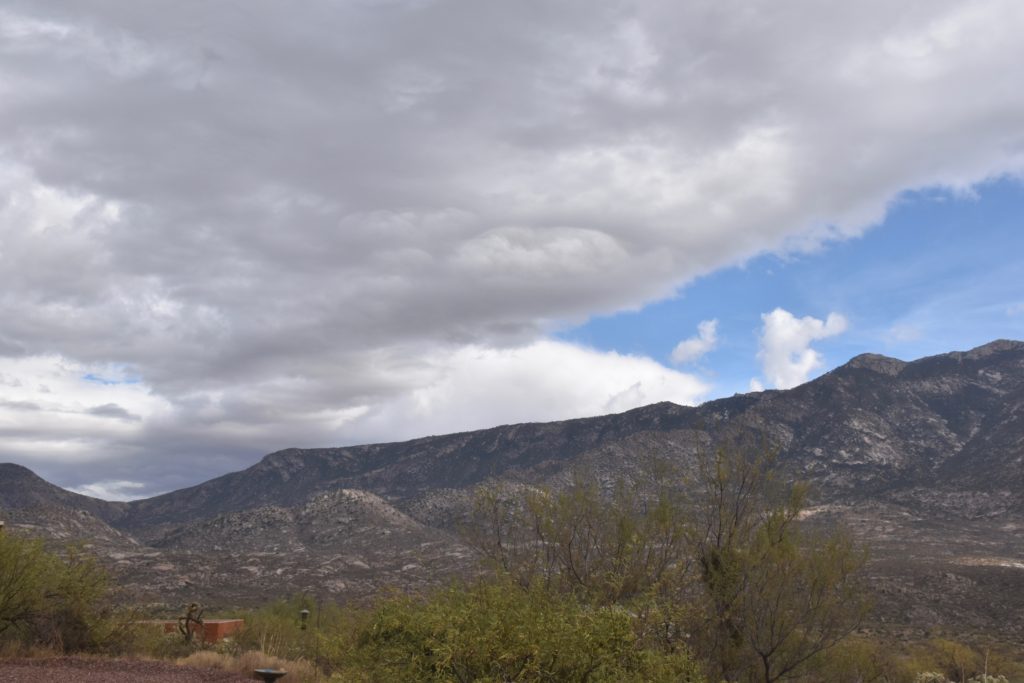
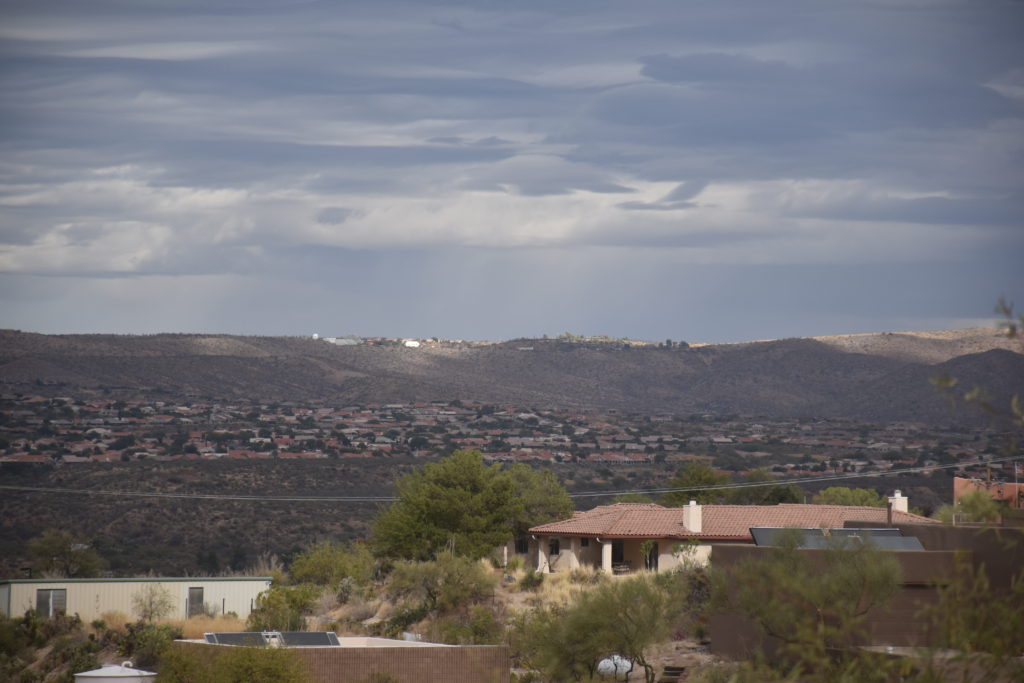
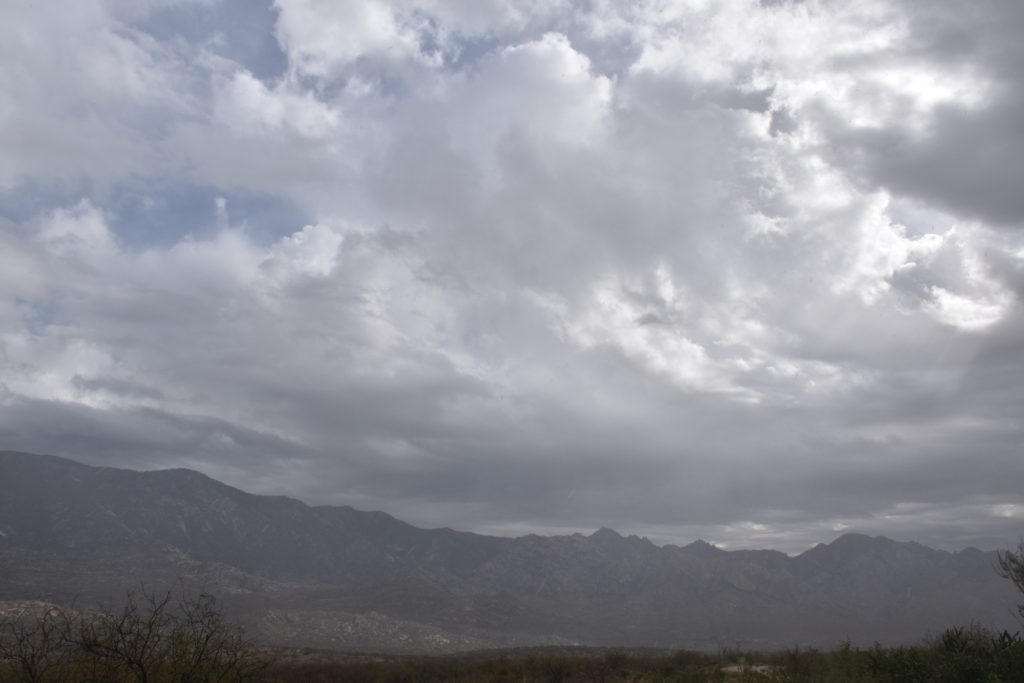
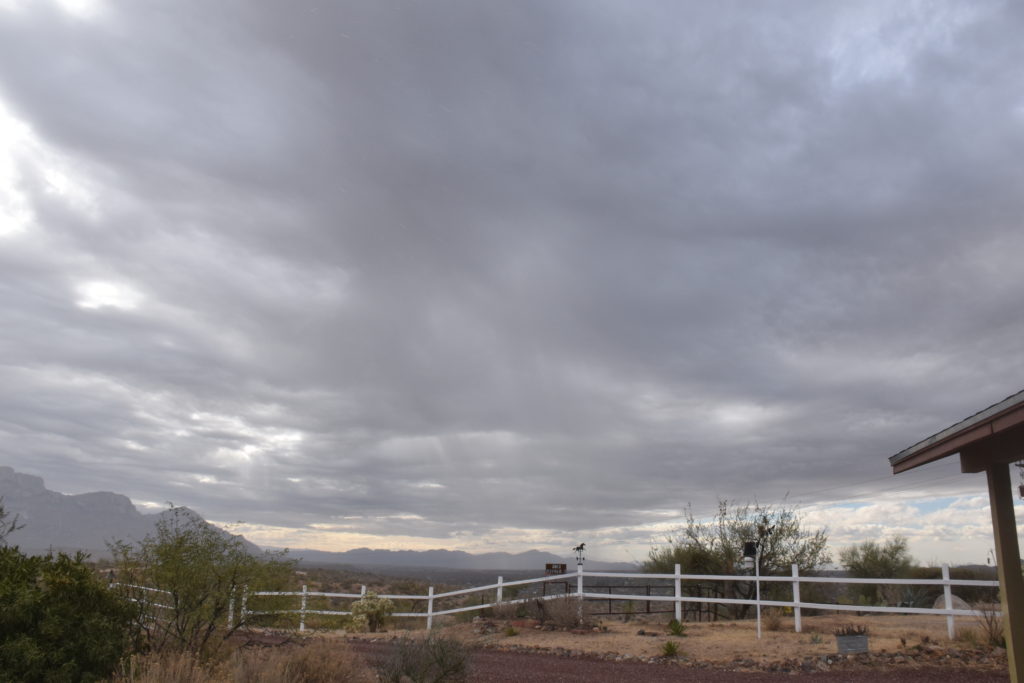
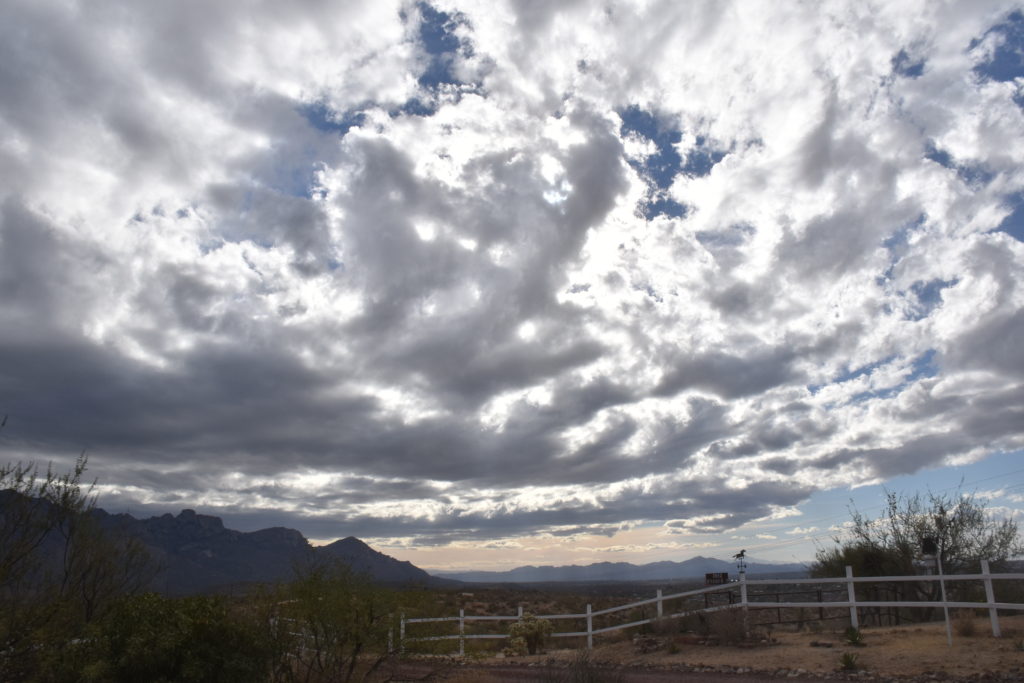
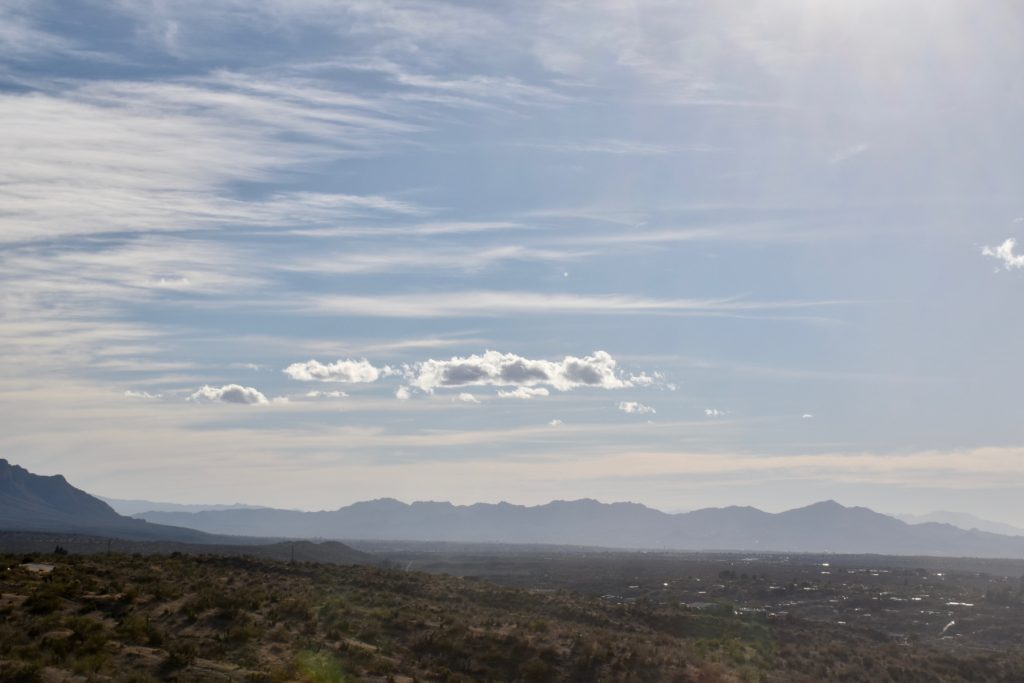
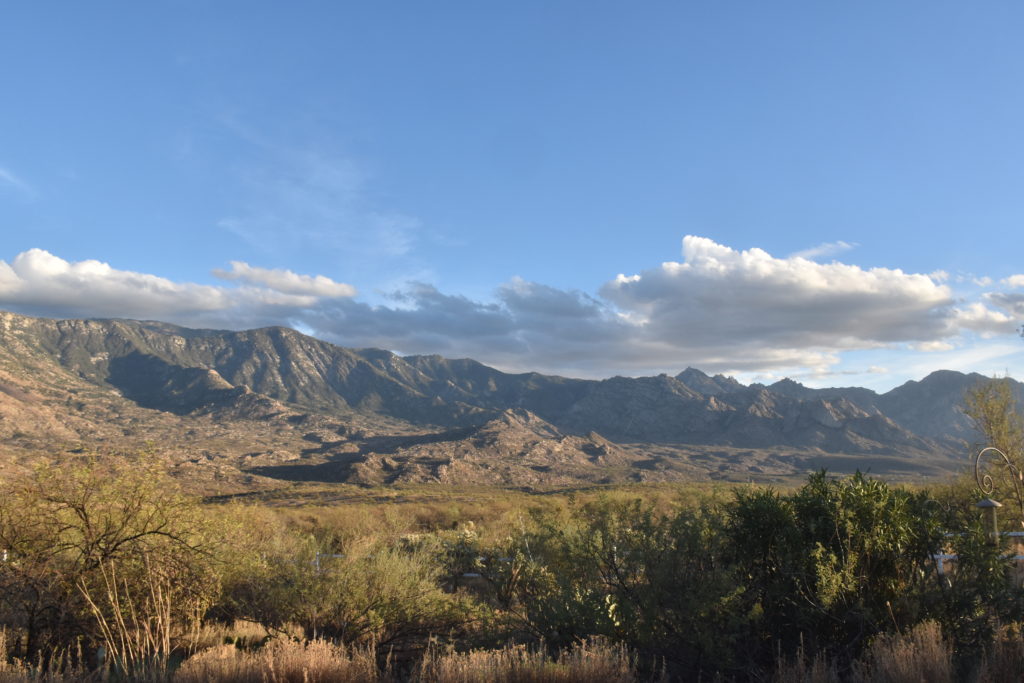
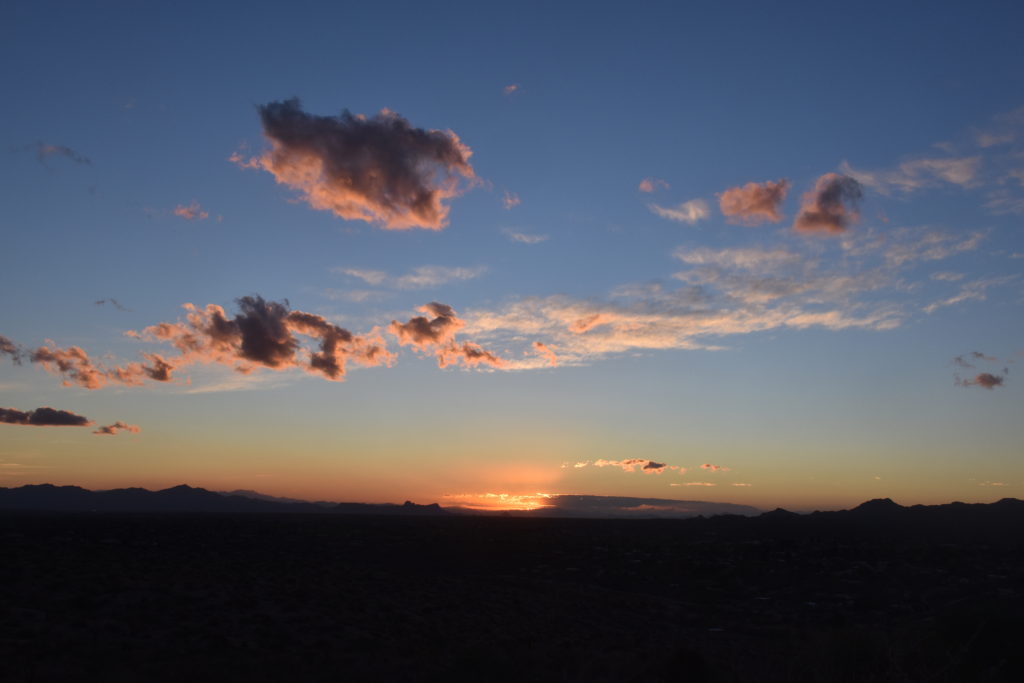
After the last drops fall today, we’ll suffer through another dry spell and warm up though about the 20th when a major trough passes by.
The End
Oops…. Have cameras ready for a great day of cloud shots once the sun breaks through.
“Rain on tap” does not refer to a microbrew, for those who’ve accidentally stumbled onto this site.
Our nice sunrise and sunset, featuring supercooled1 Altocumulus clouds:
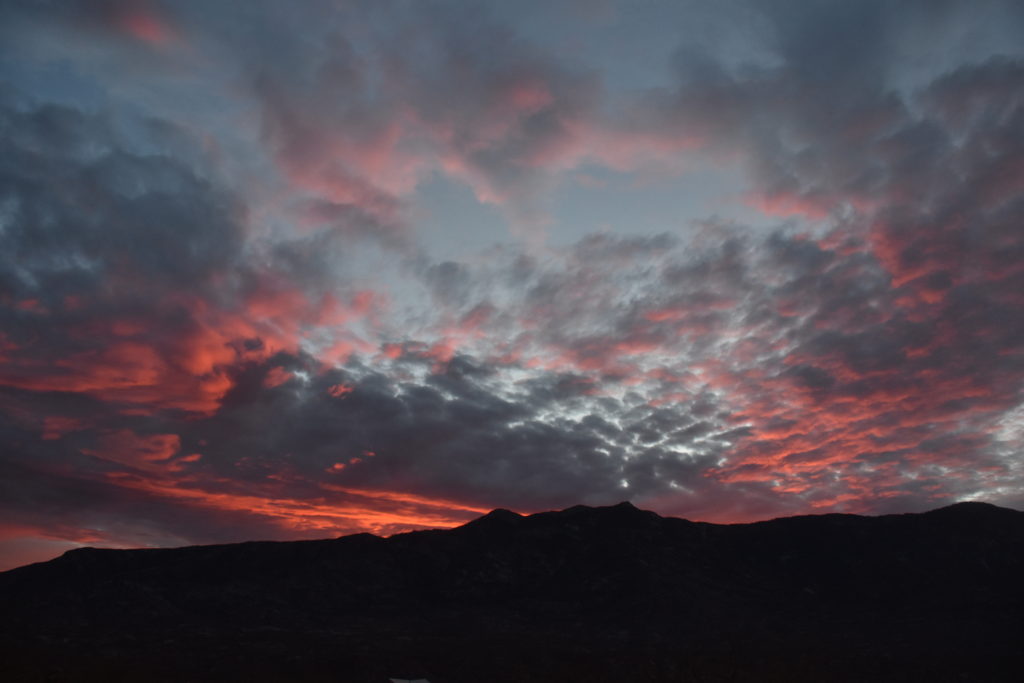
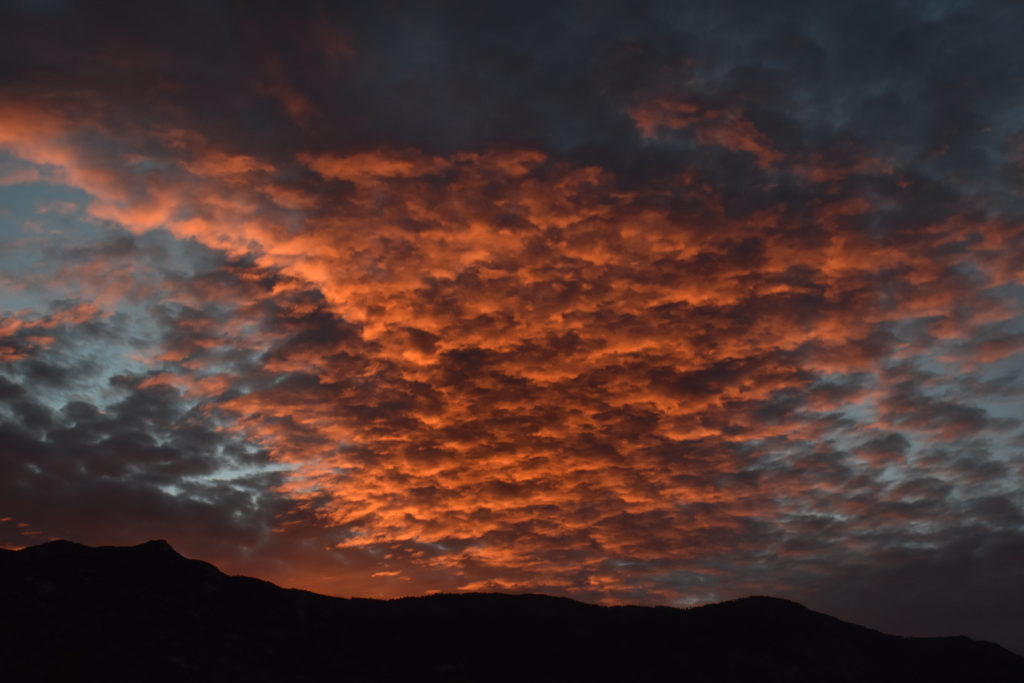
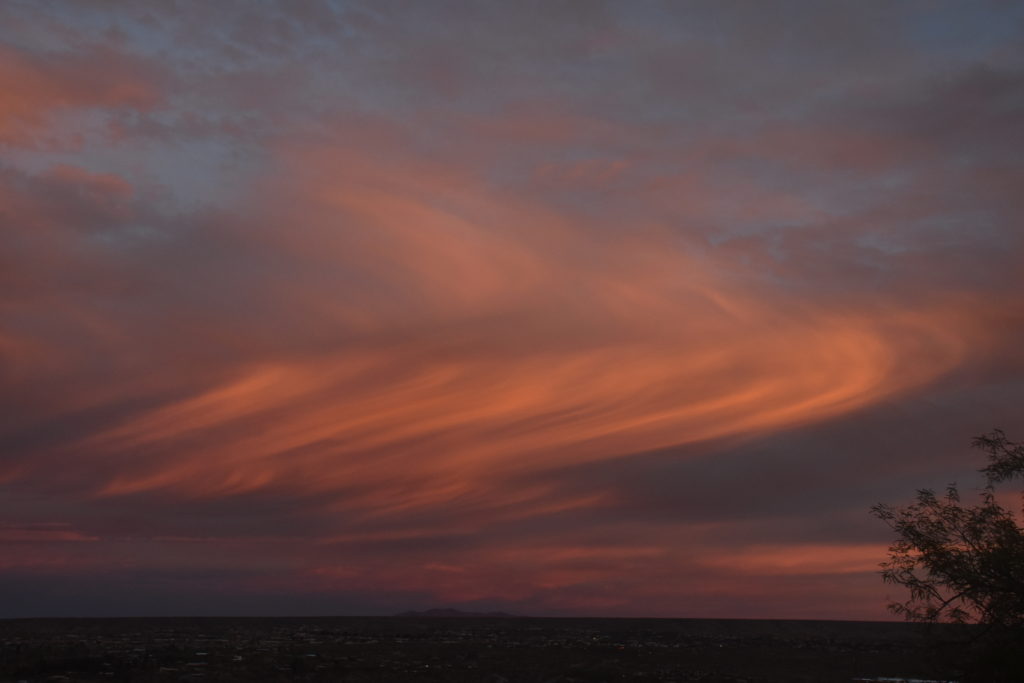
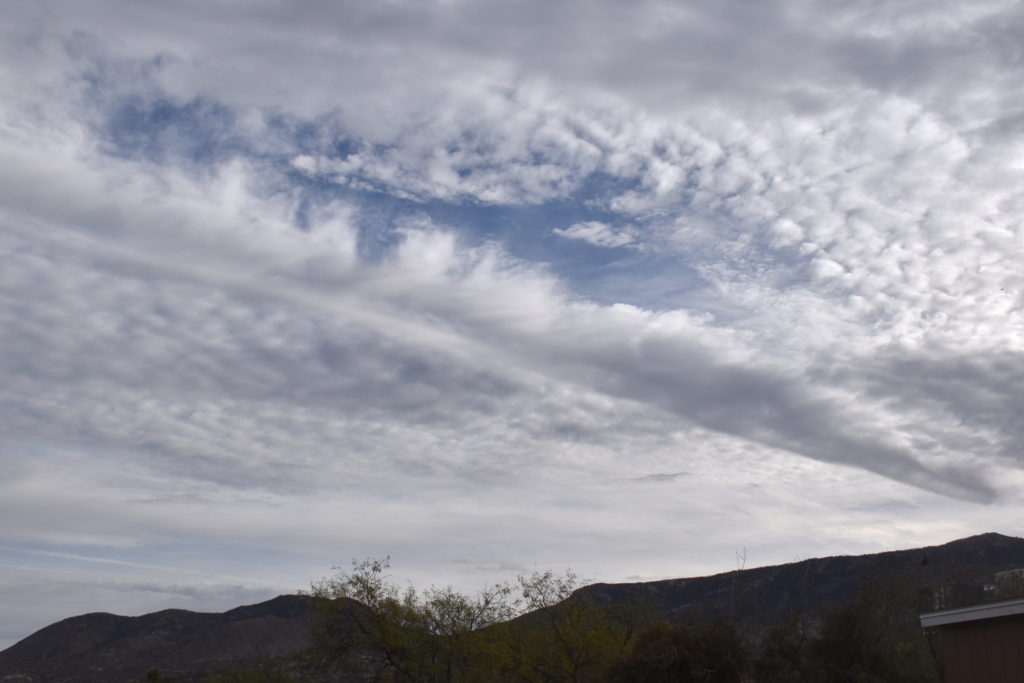
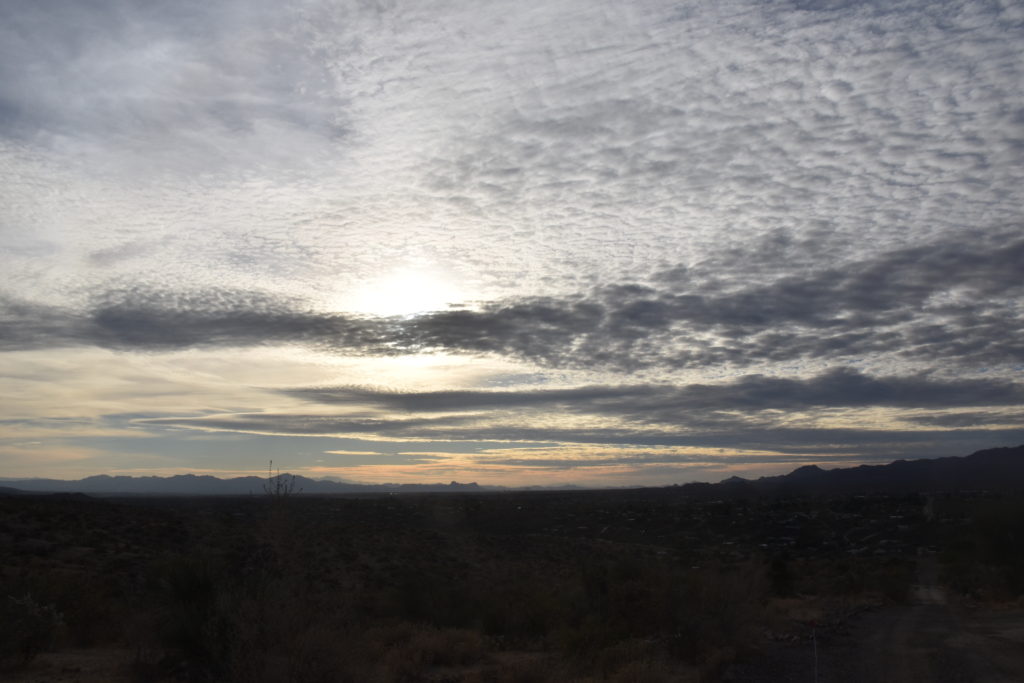
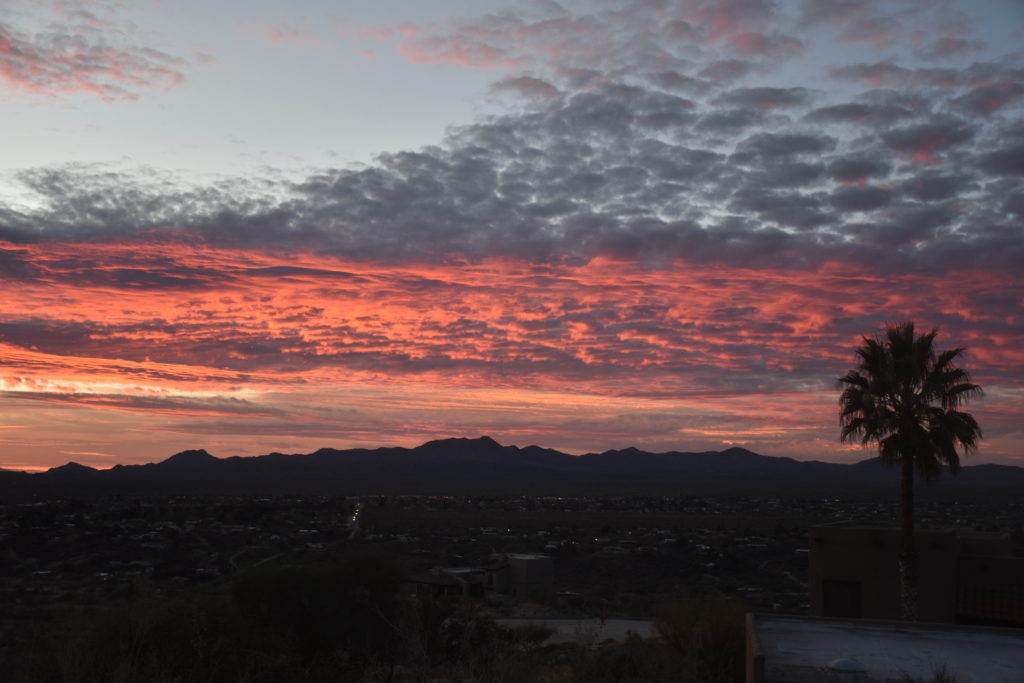
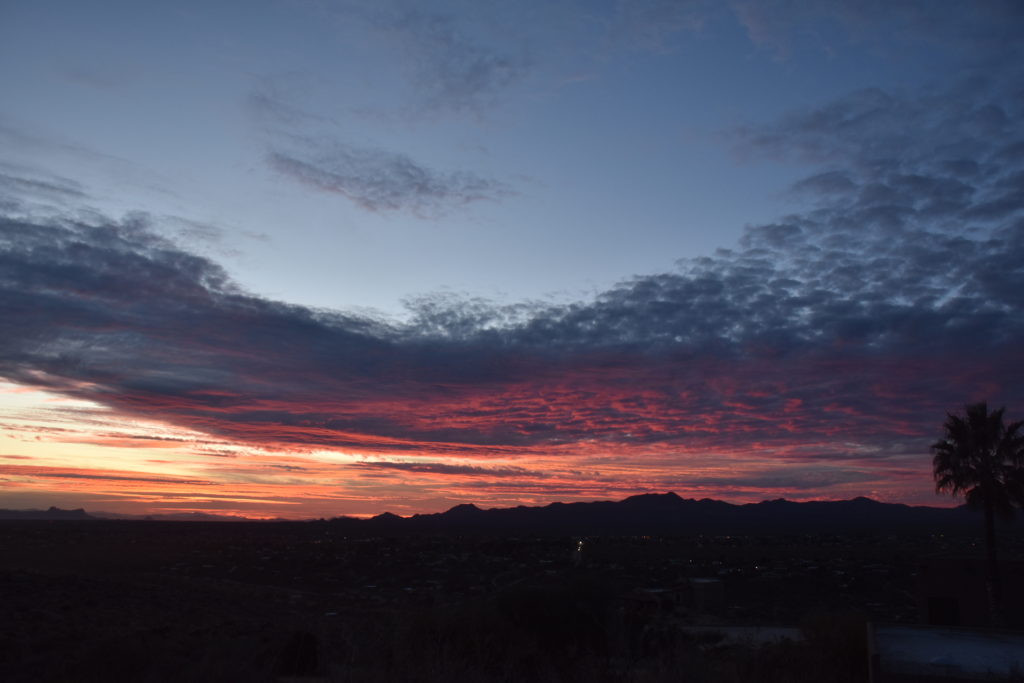
Rain on tap? Oh, yeah….finally. One forecaster friend is predicting 0.5 inches! How nice would that be? The rain will likely begin toward midnight–check it here from our nice U of AZ Weather Department.
Looking for more rain in AZ after mid-month, toward the 20th.
The End
A swatch of Altocumulus perlucidus translucidus (sorry, that’s the way we talk around here) passed over Catalina early yesterday afternoon, each “unit” nearly perfectly evenly spaced with its fellow cloud element creating a brief period of cloud awe for those Catalinans (or is it, “Catalina-ites”? “Catalinians”? Who knows, who cares?). Here it is, in case you work indoors and missed it. It was truly a fabulous sighting!
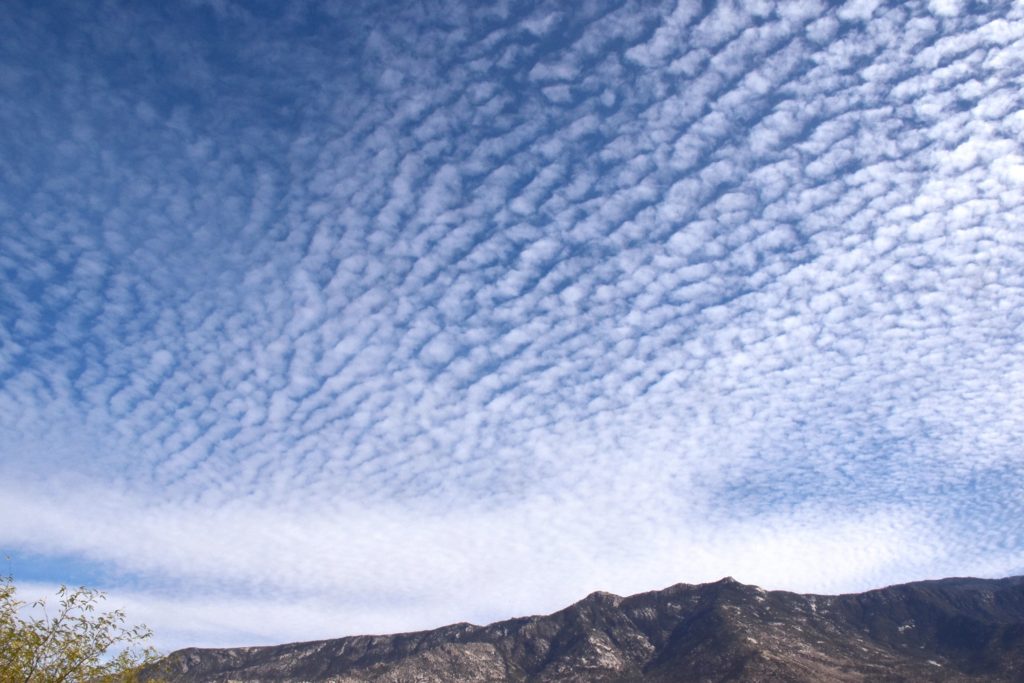
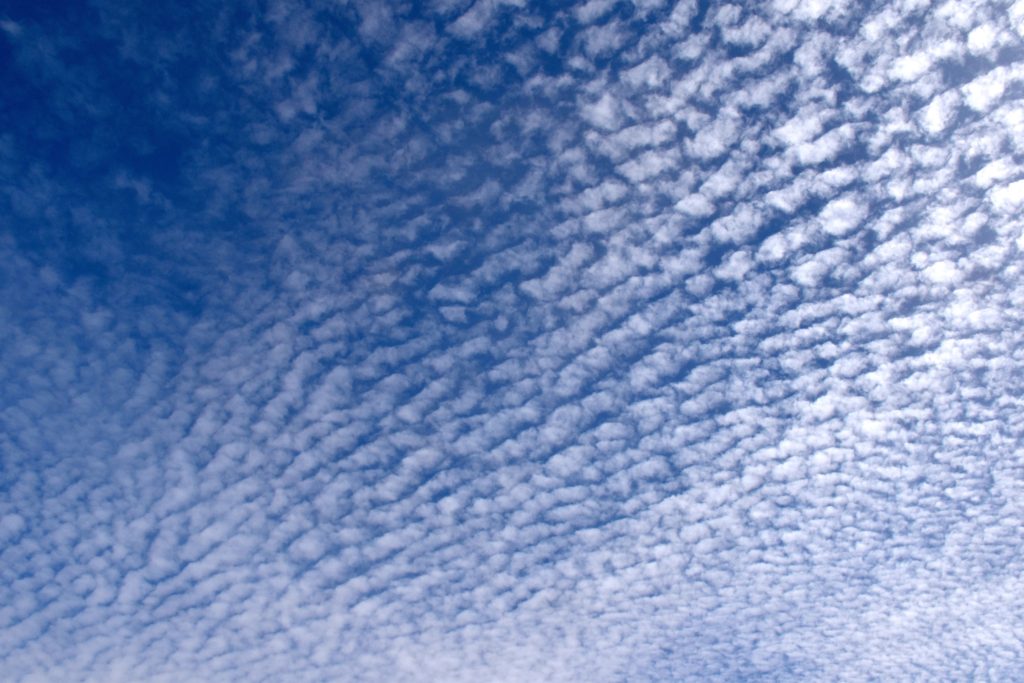
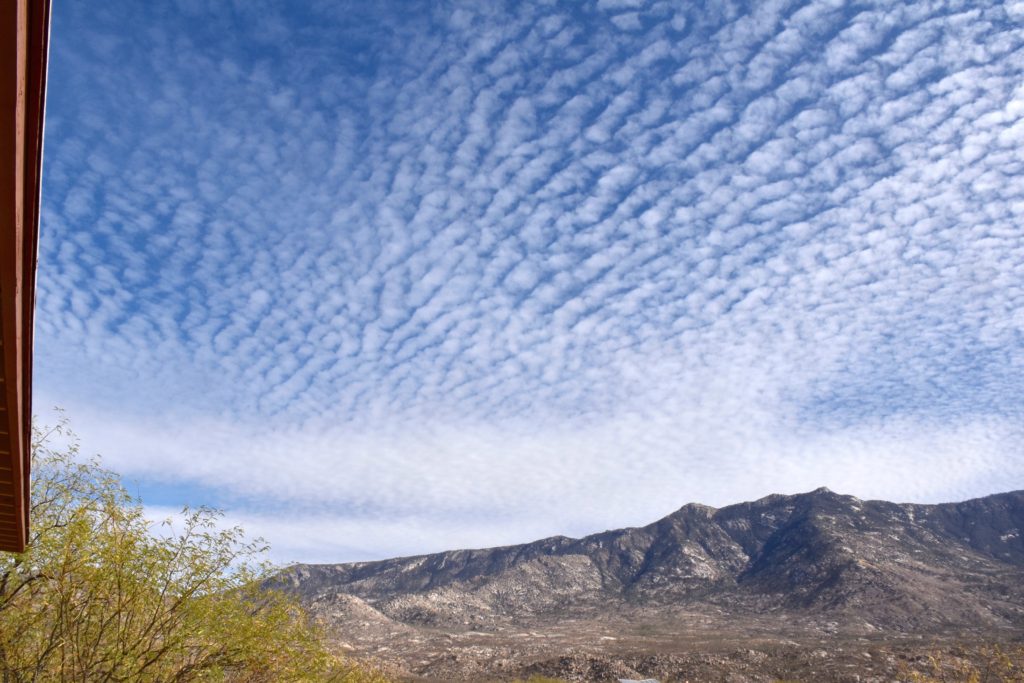
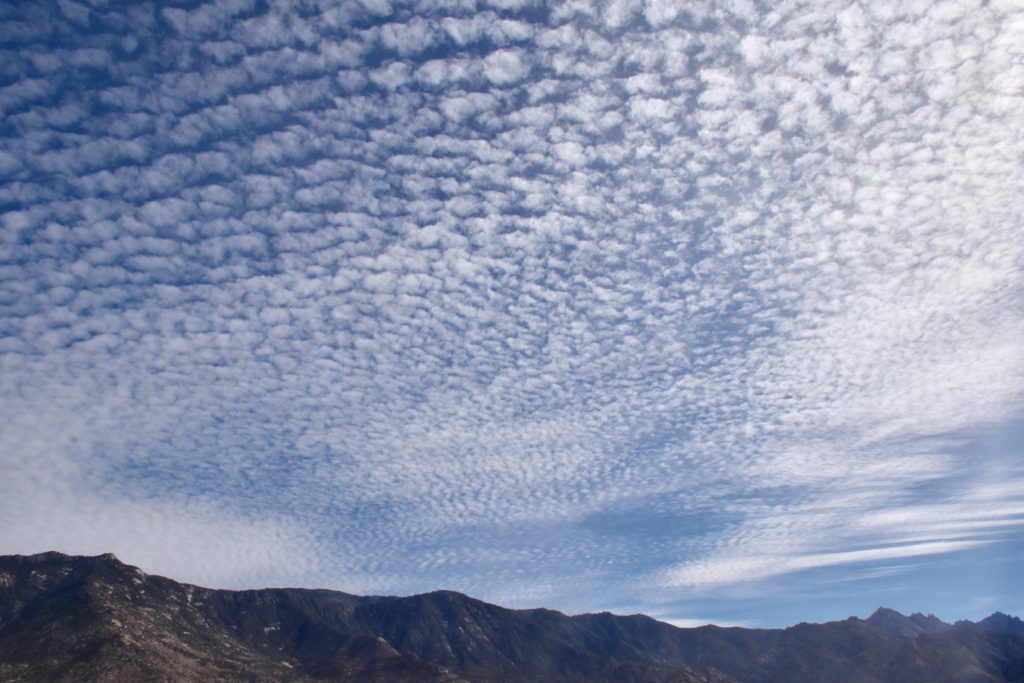
The afternoon was marked by a melange1 of middle clouds:
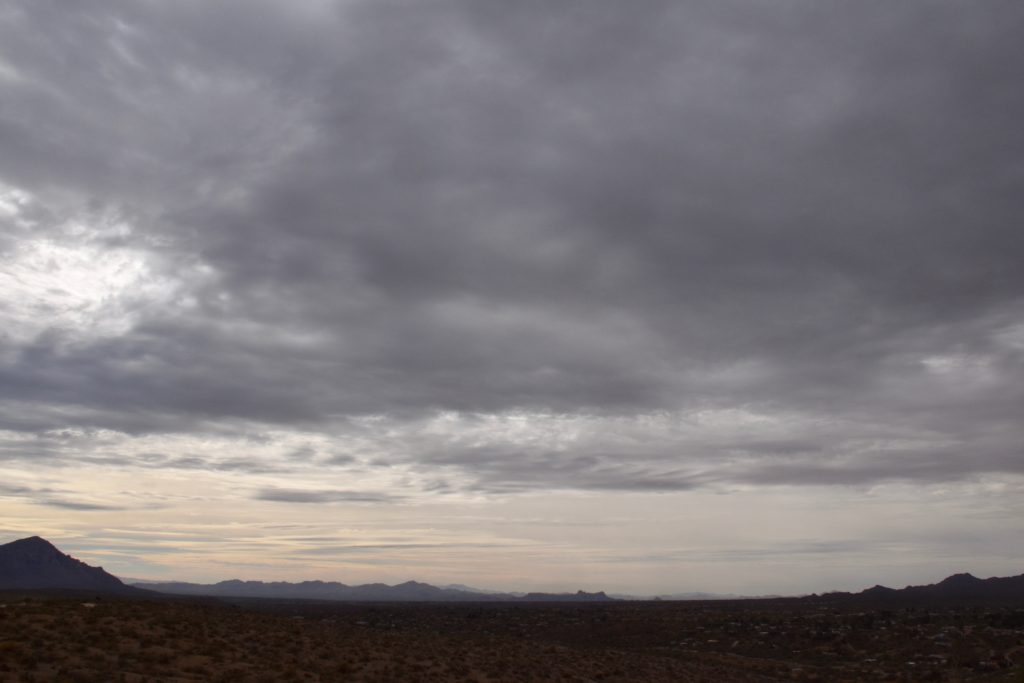
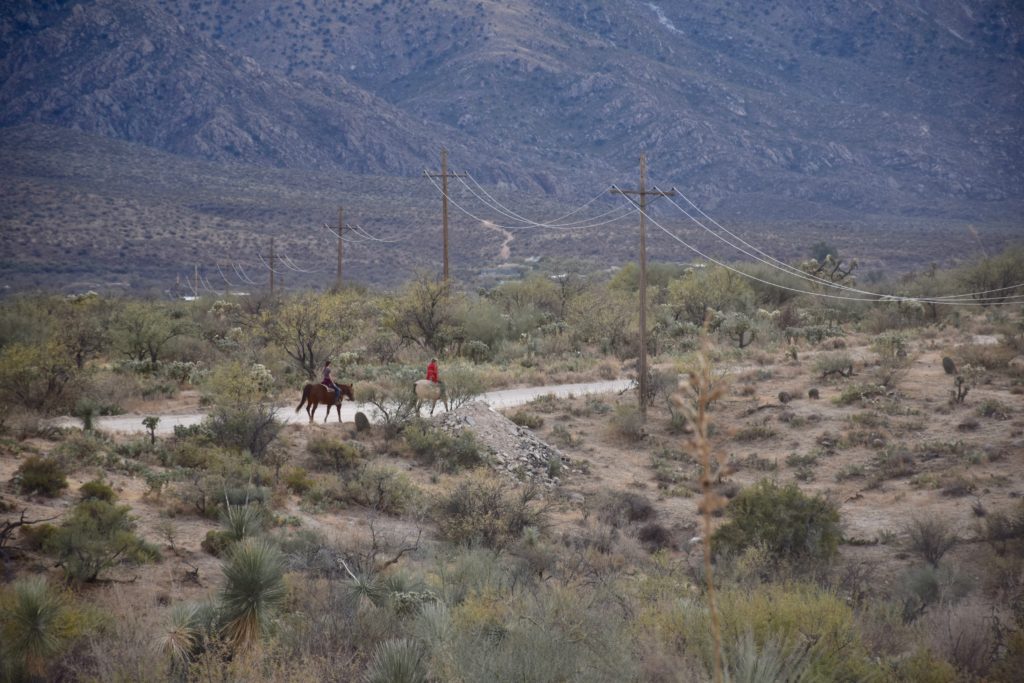
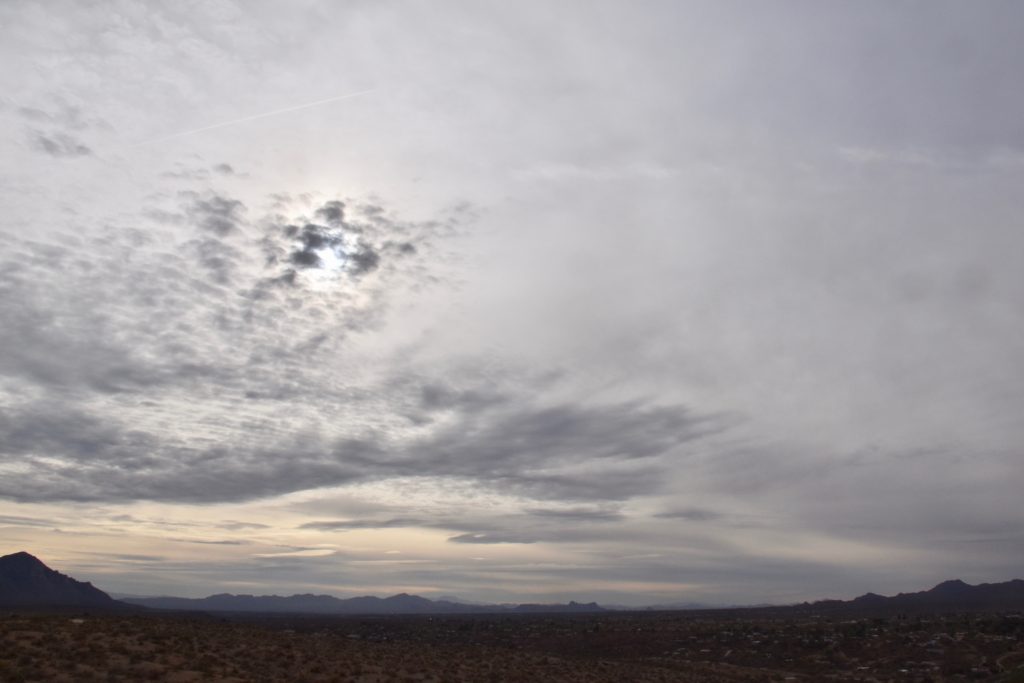
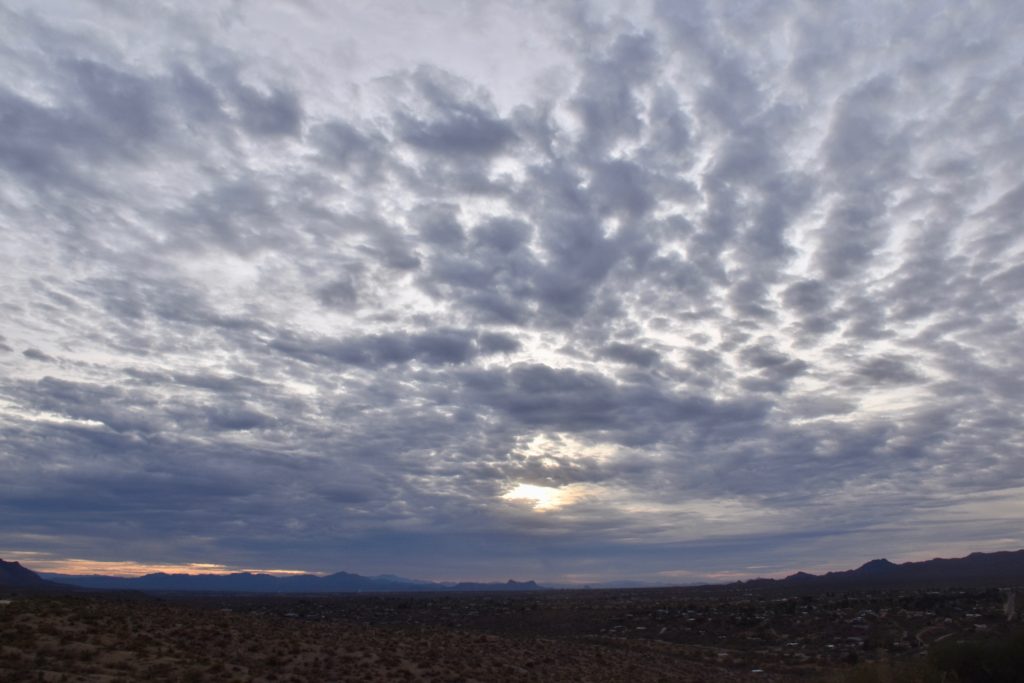
The local TEEVEE met men are, of course, pounding out the good news rain is just ahead for Catalina. Looks like, oh, 100% chance to CMP (Cloud Maven Person) starting after midnight Tuesday to Wednesday. How much?
This is a potent, but fast moving trough. Maybe will have only 2-4 h of rain with the passage of the cold front and its rainband. But, coming from the sub-tropics, should have a appreciable rain band with it.
I would expect rainrates to reach “moderate” as the heart of the band goes by for a coupla hours, anyway. Moderate rain is defined by the NWS as 0.1 to 0.3 inches per hour. So, only two hours of moderate rain should be at LEAST 0.2 inches, and most likely more.
We’re thinking here that there’s a 90% chance of more than 0.15 inches, and a 90% chance of less than 0.70 inches. So, averaging those two leads to a best estimate in CMP’s opinion of 0.425 inches! Wow. Nice.
Now, I will look at the U of AZ nested model and see what it thinks. Kind of game we play here, seeing how a seat of the pants forecast, made over a coupla minutes, measures up to a computer model with billions if not trillions of calculations:
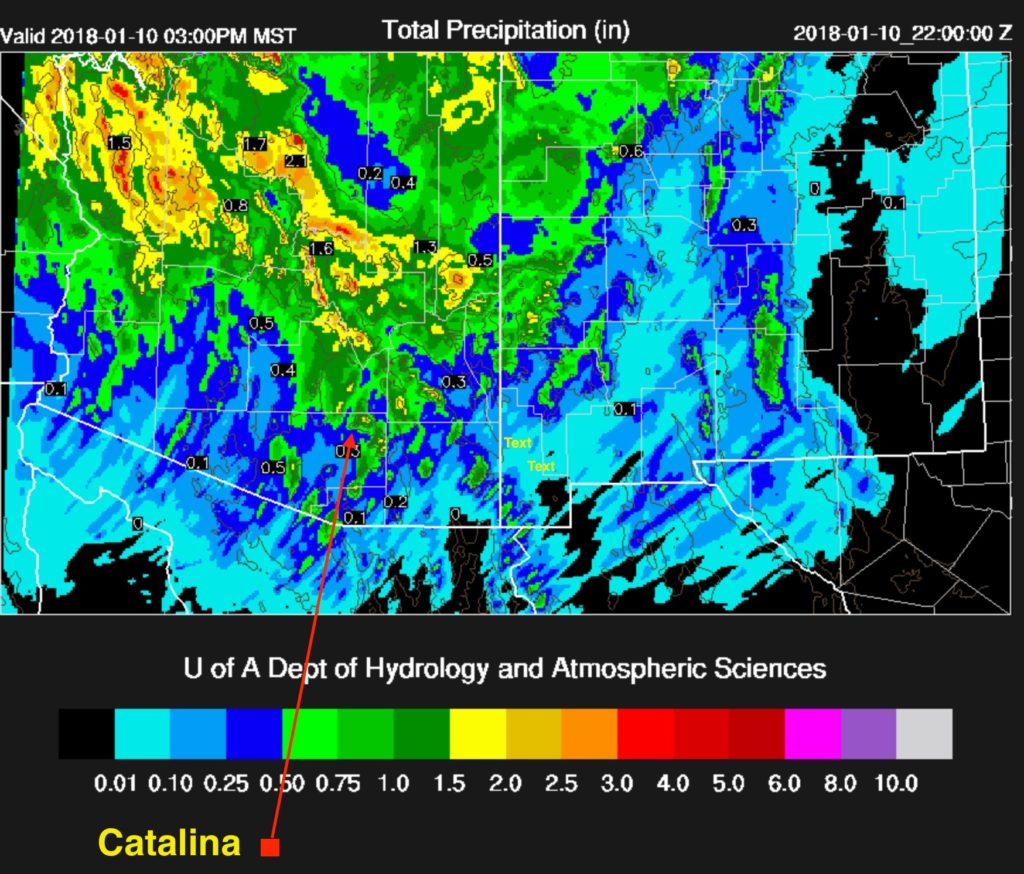
After the nice rain just ahead, we have to get through the week-long dry spell before we move into a new stormy regime. First, a spaghetti depiction of the ridge after our nice storm:
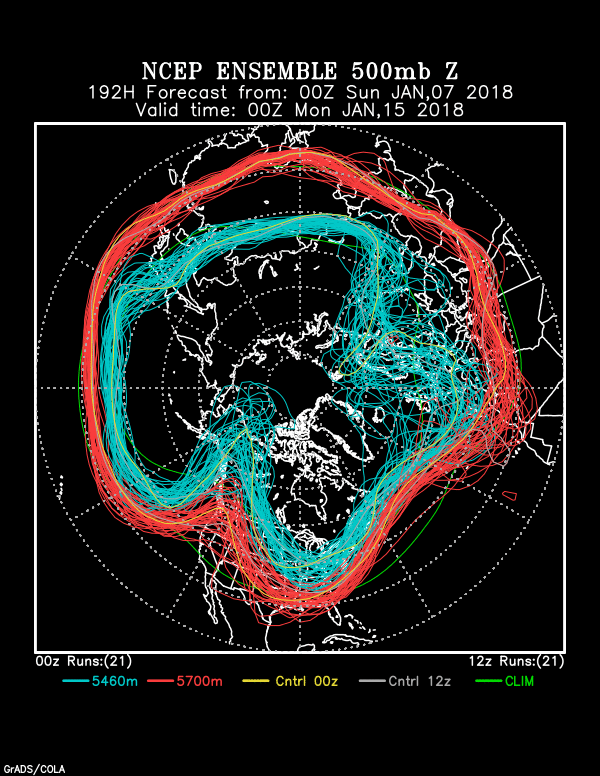
Here’s what’s been exciting for a few days now, and below, from last evening’s global model output:
Let’s see what the actual and very latest model run from IPS Meteostar has for us:

How much these coming rains can benefit our spring wildflower bloom and spring grasses I don’t know, but I sure hope they can resuscitate what otherwise will be a dismal spring.
Expecting a snow event during the “new regime” that takes over after mid-month, too. Be ready!
The End
Yep, unless you were outside yesterday morning, you probably missed the few drops that fell. But fall they did, giving us officially a trace of rain for January! In case you don’t believe me, here is a shot of the incoming shafts of rain. OK, “veils” of rain.
